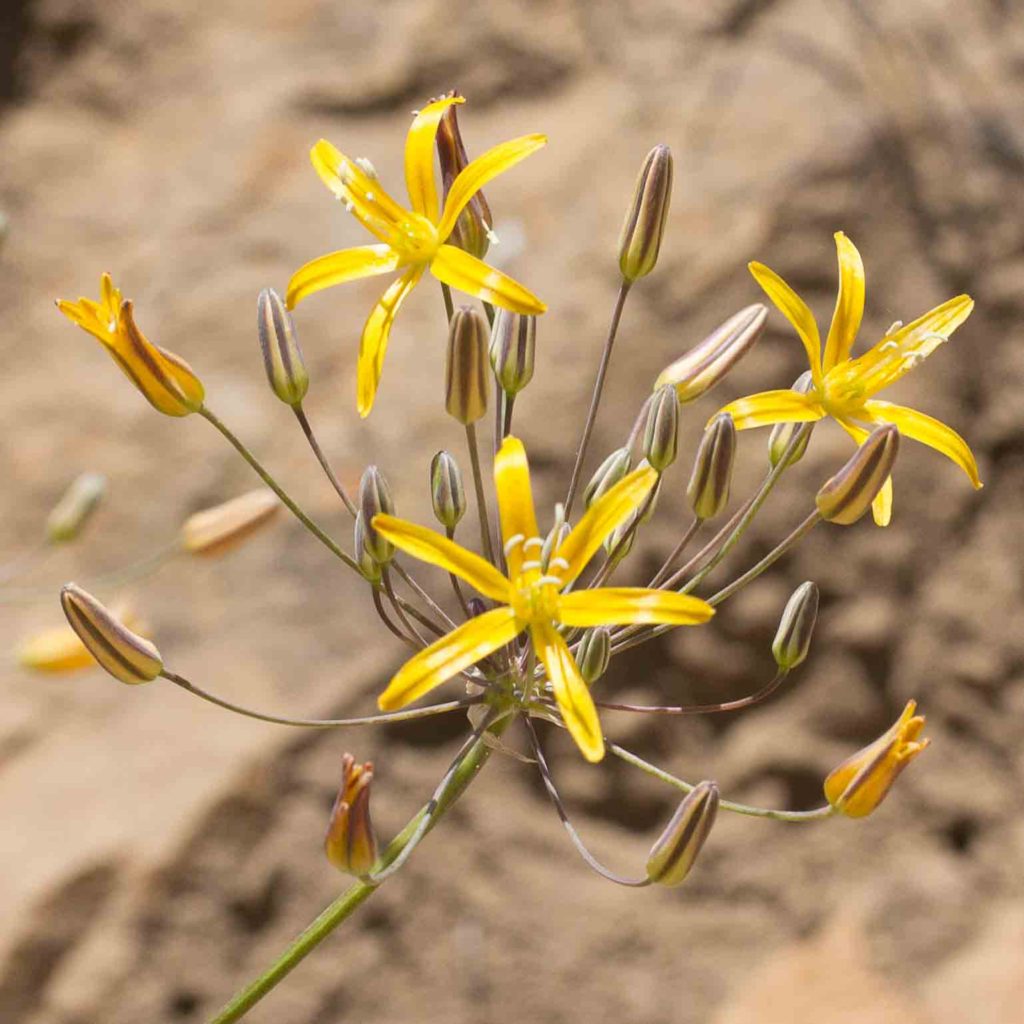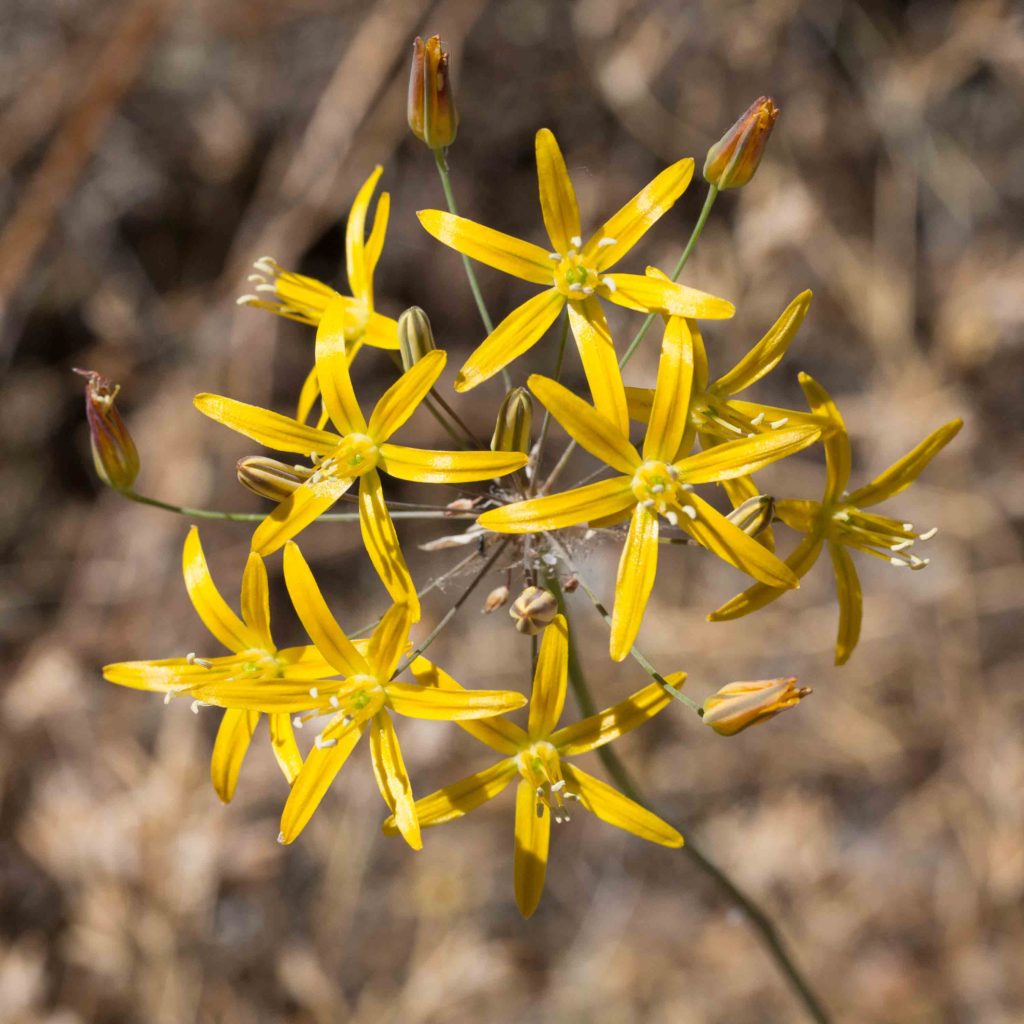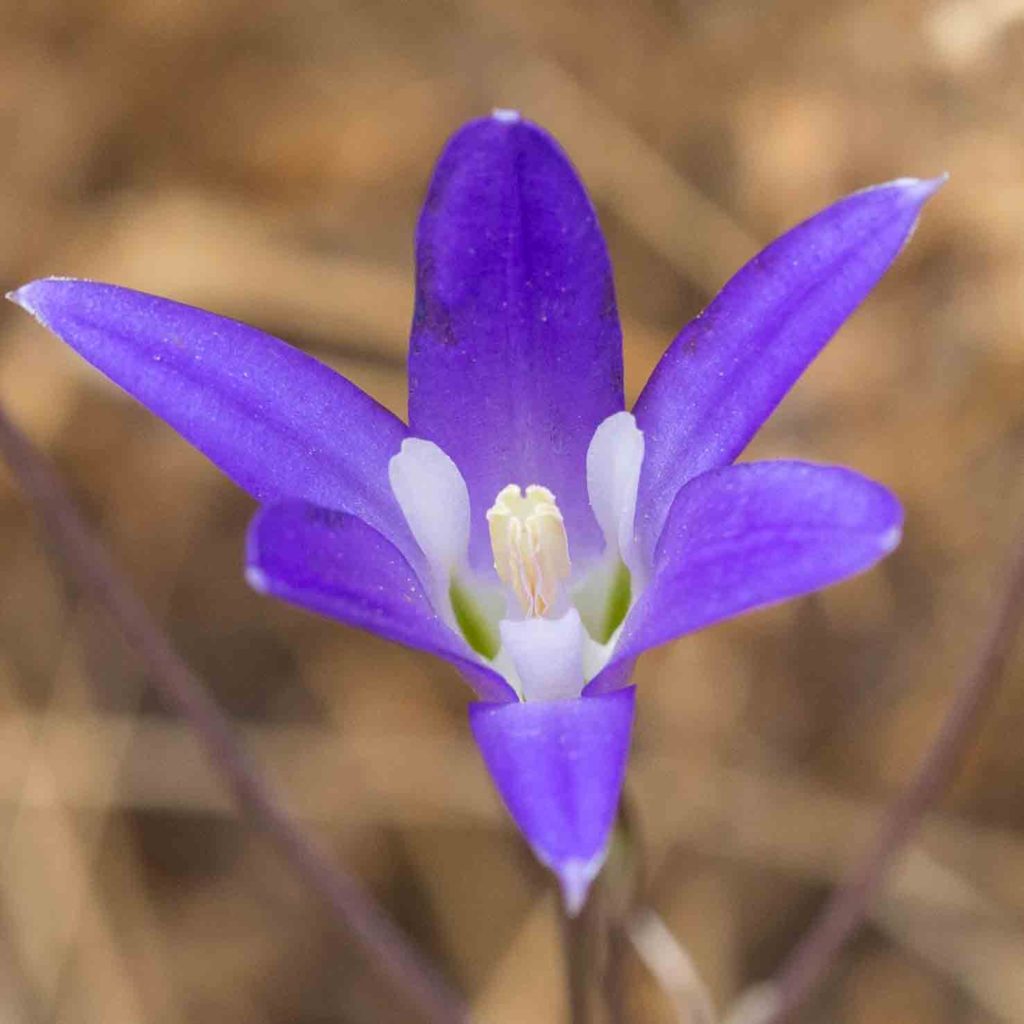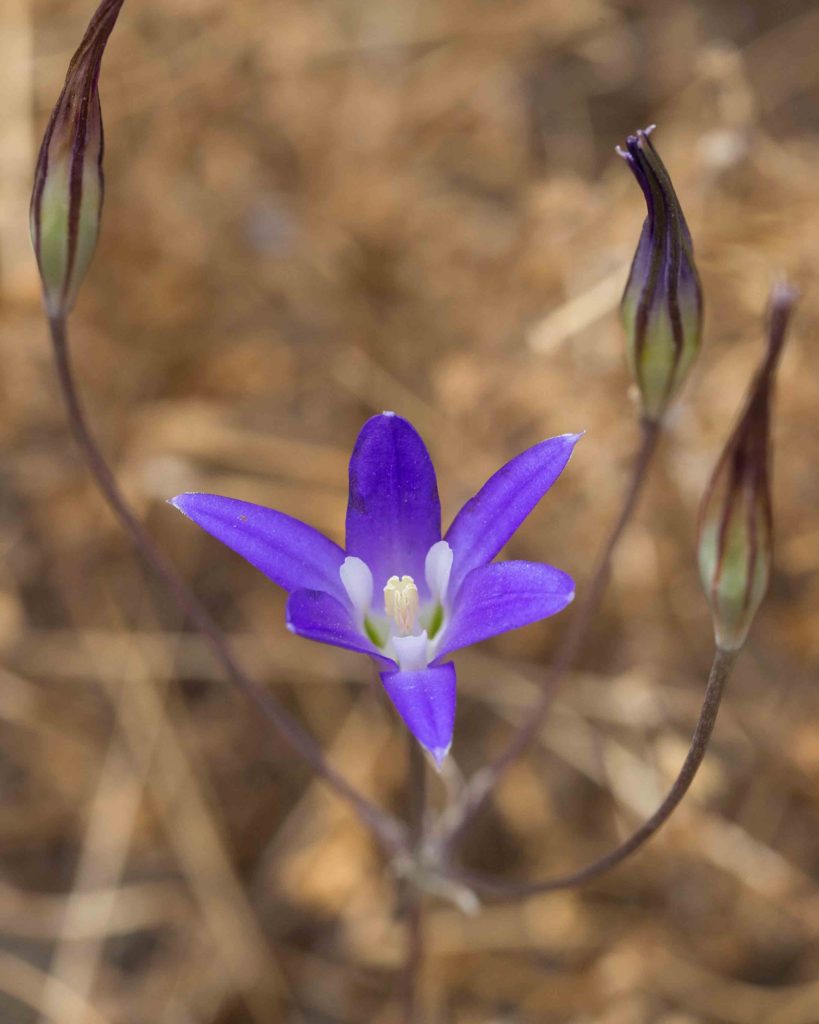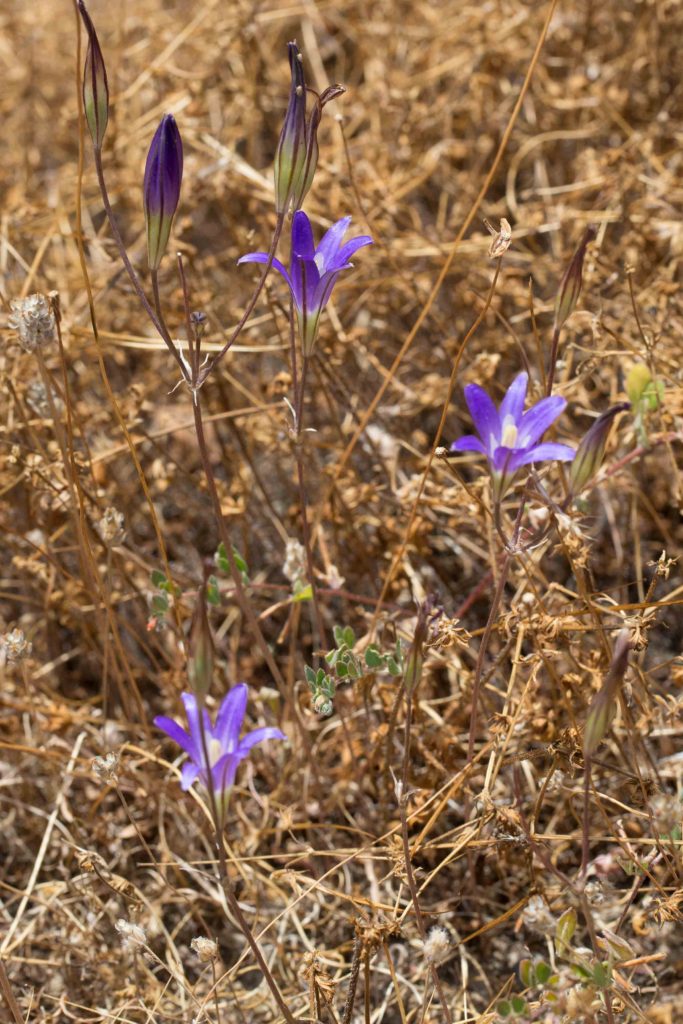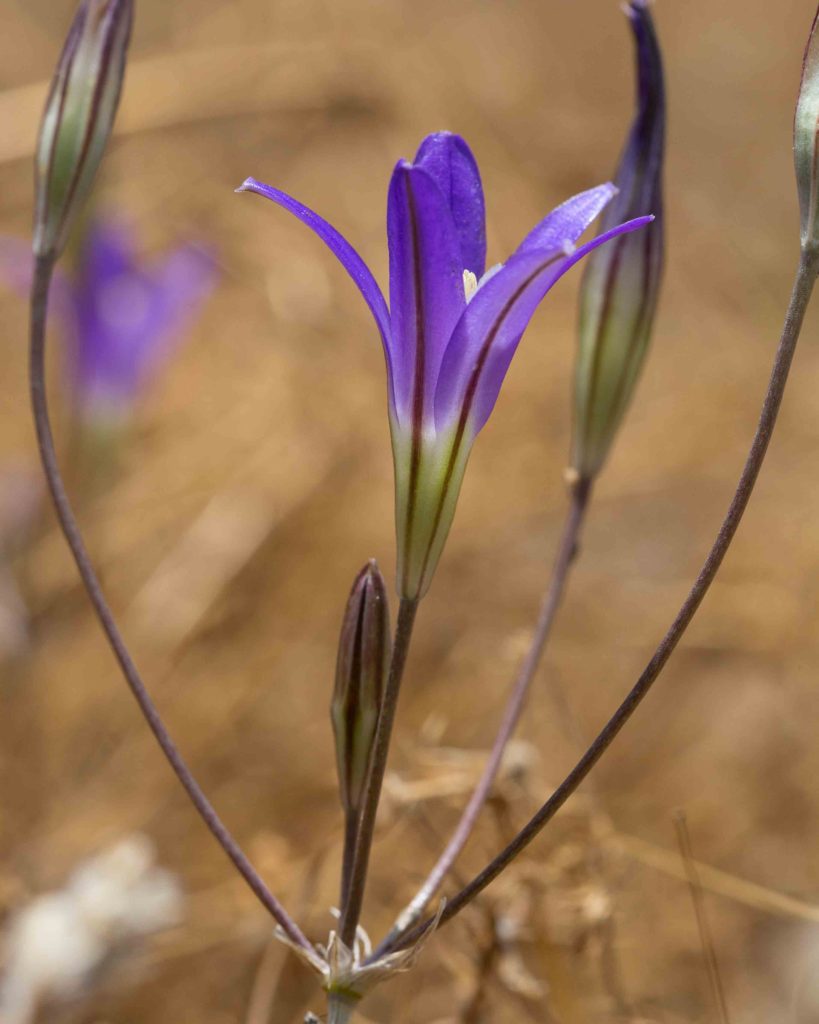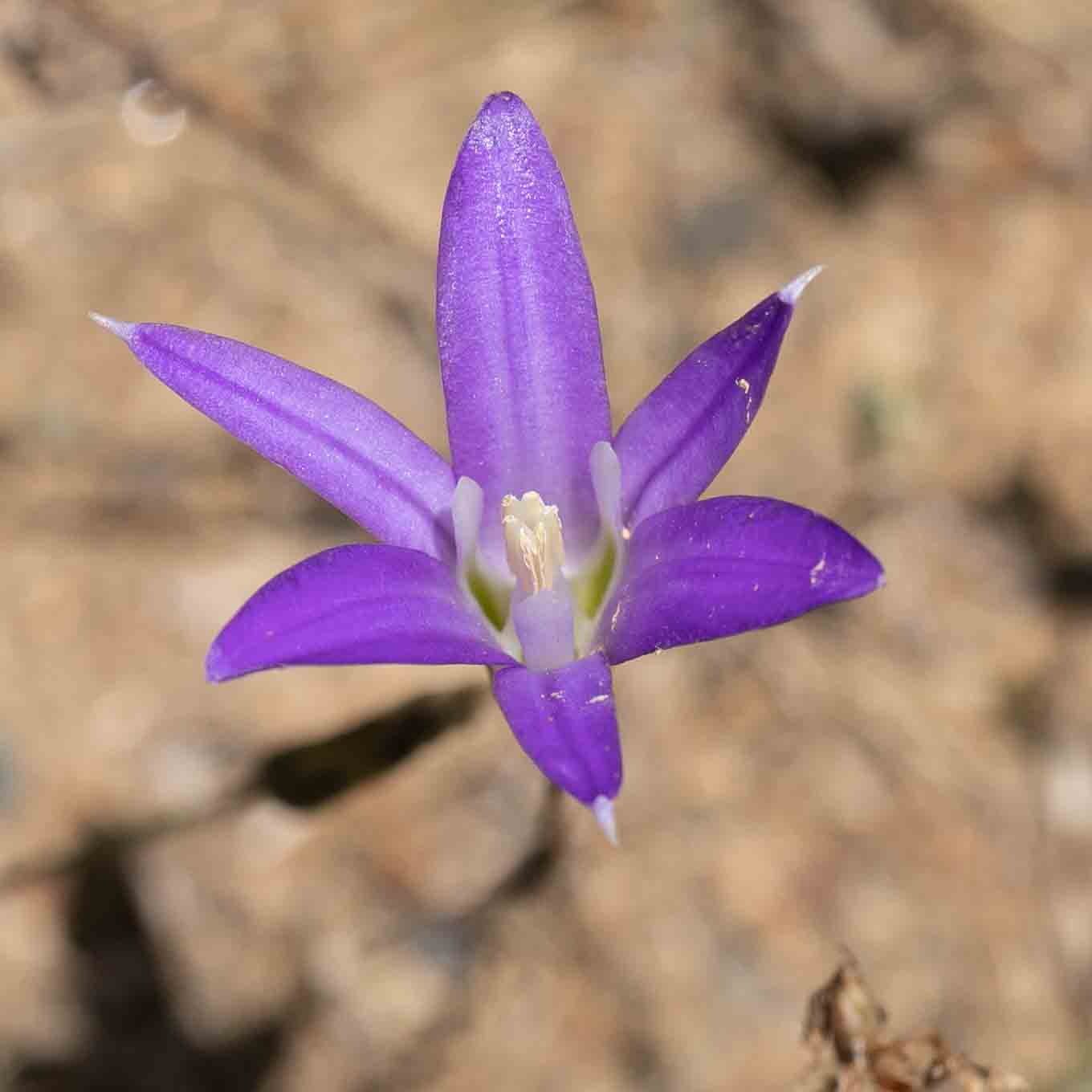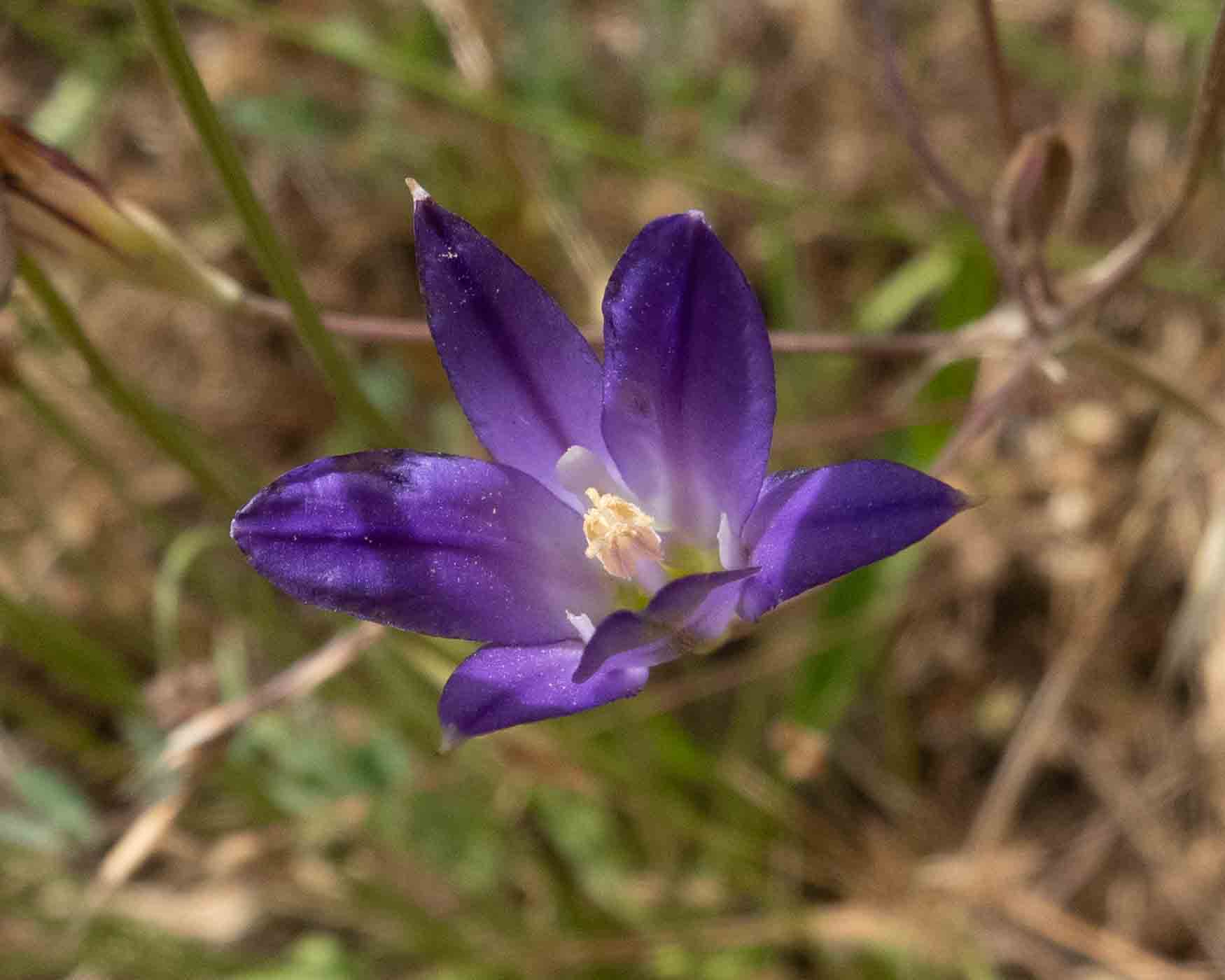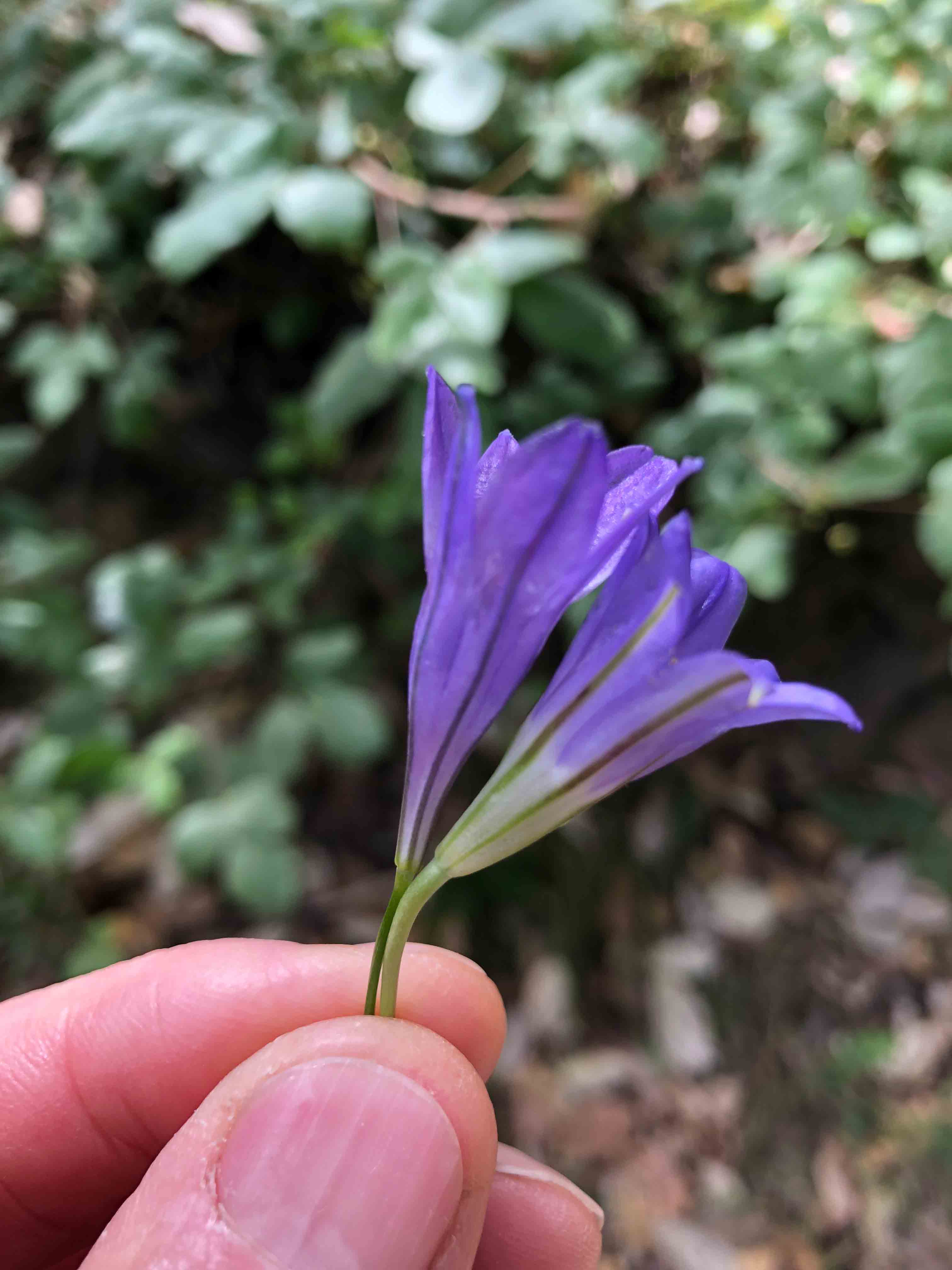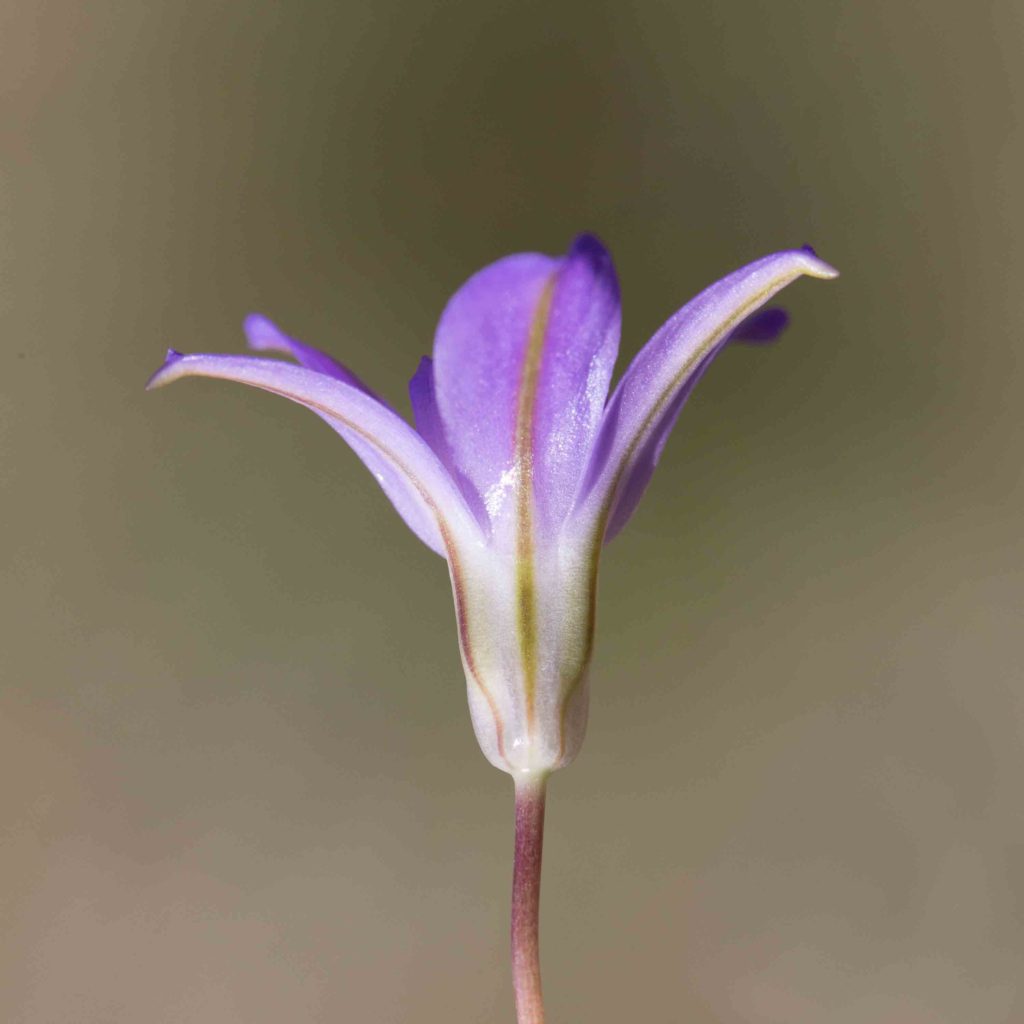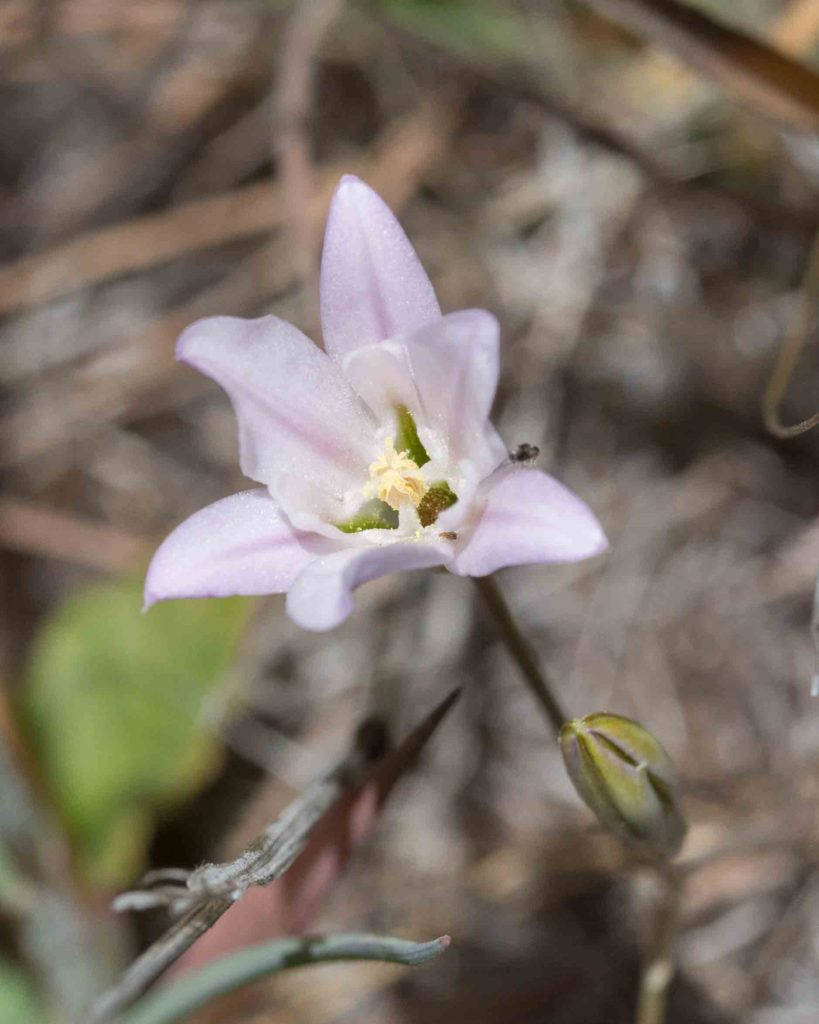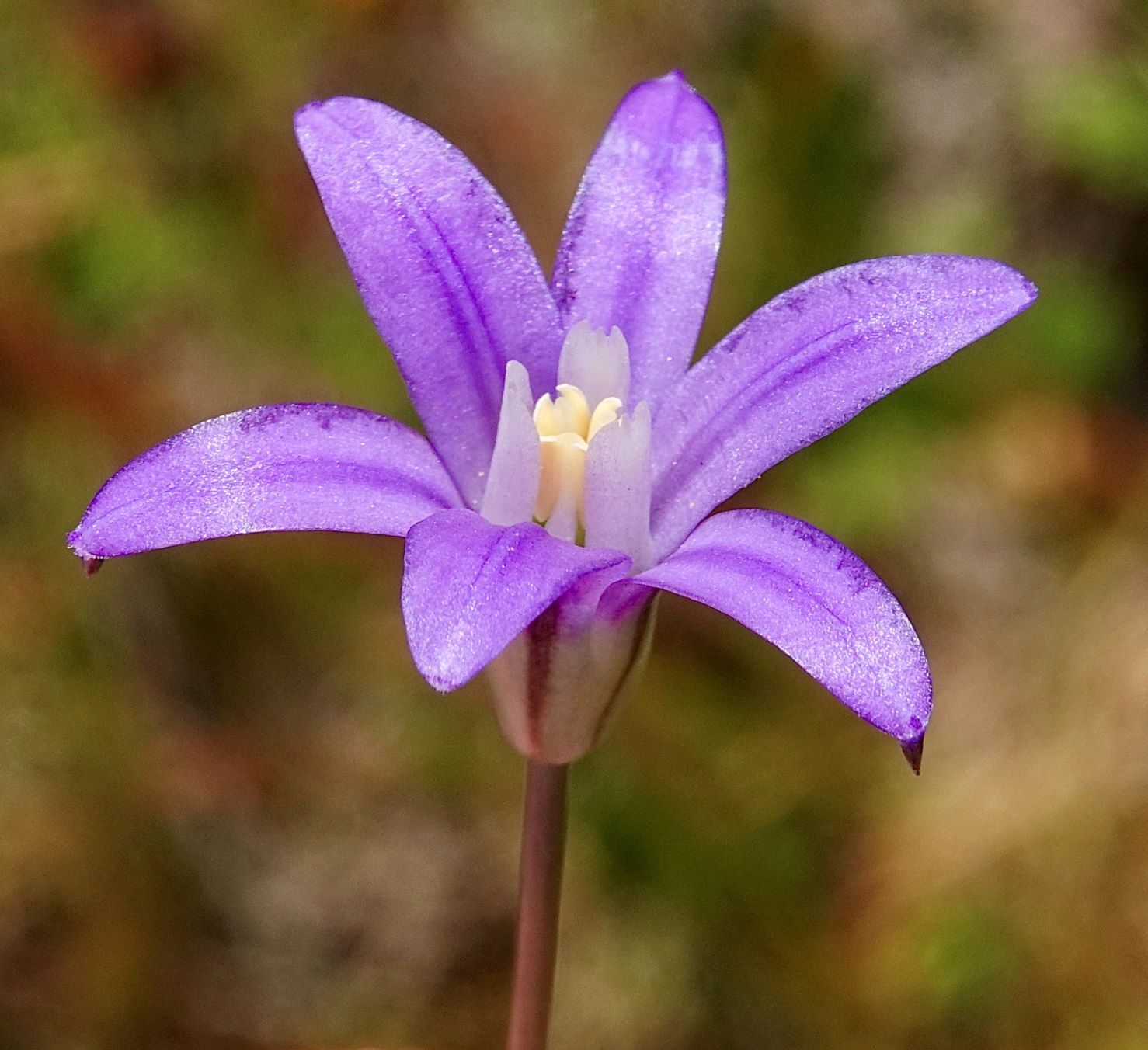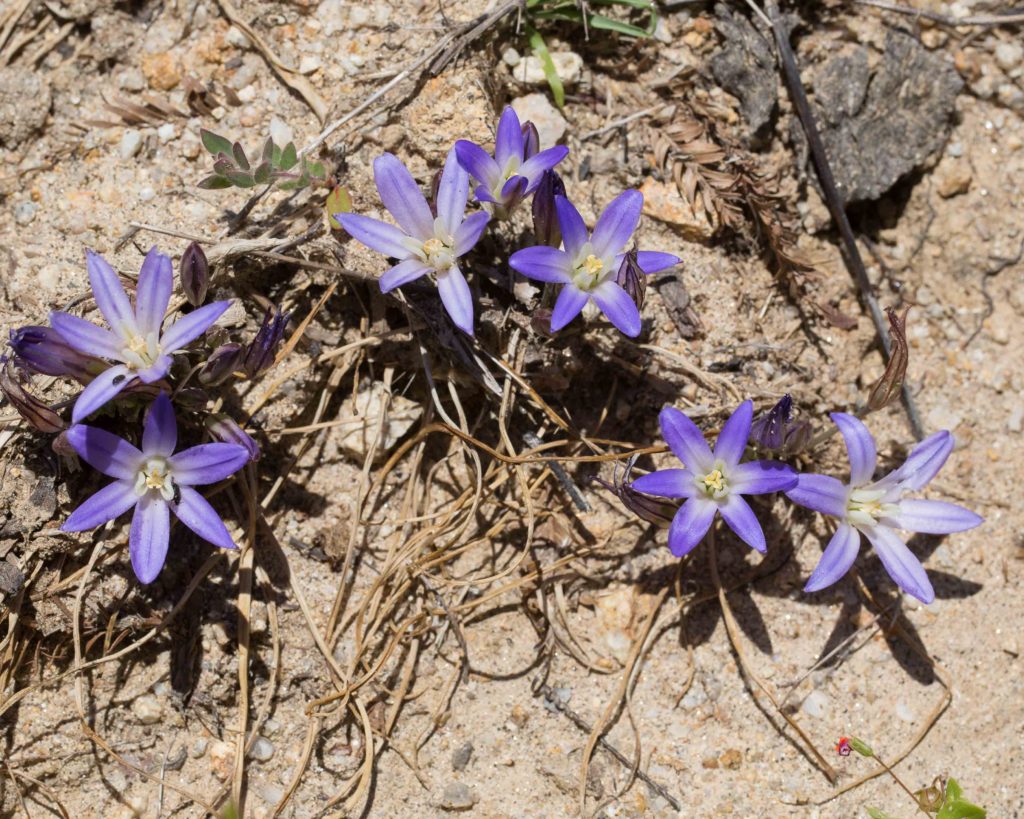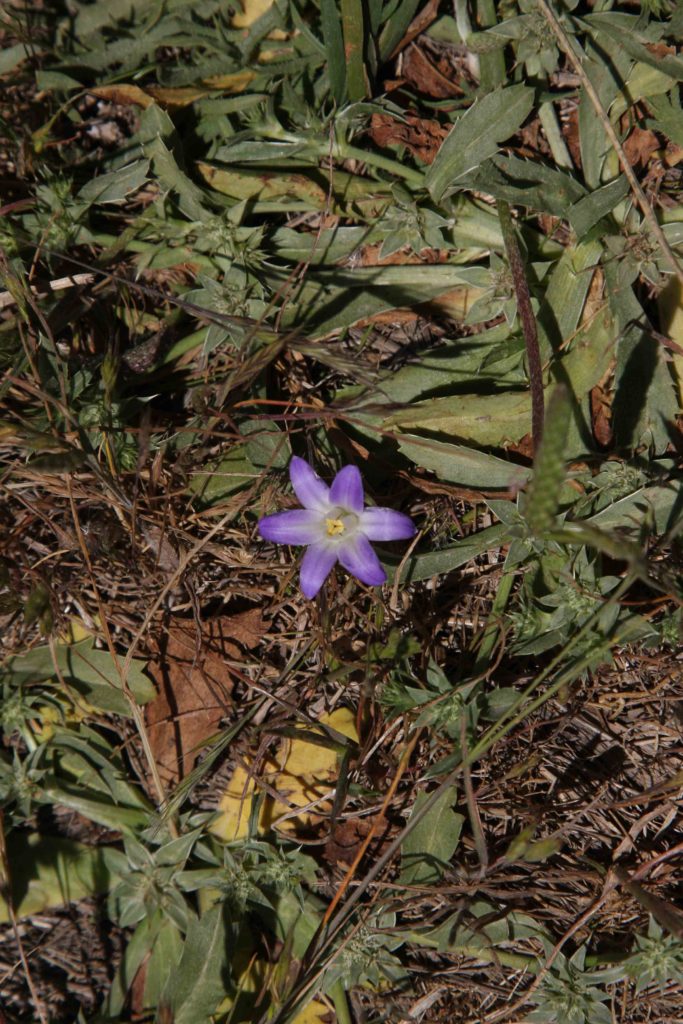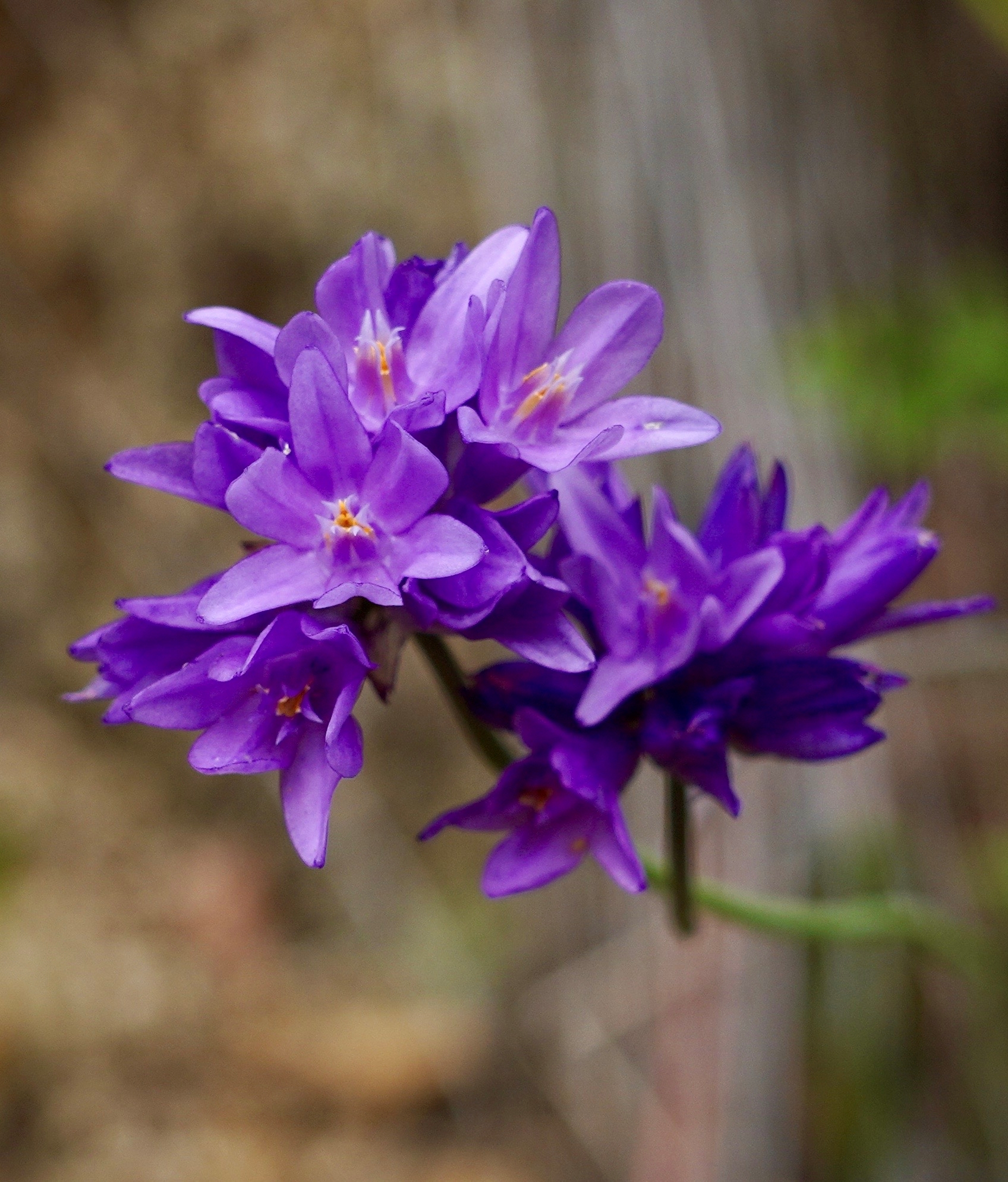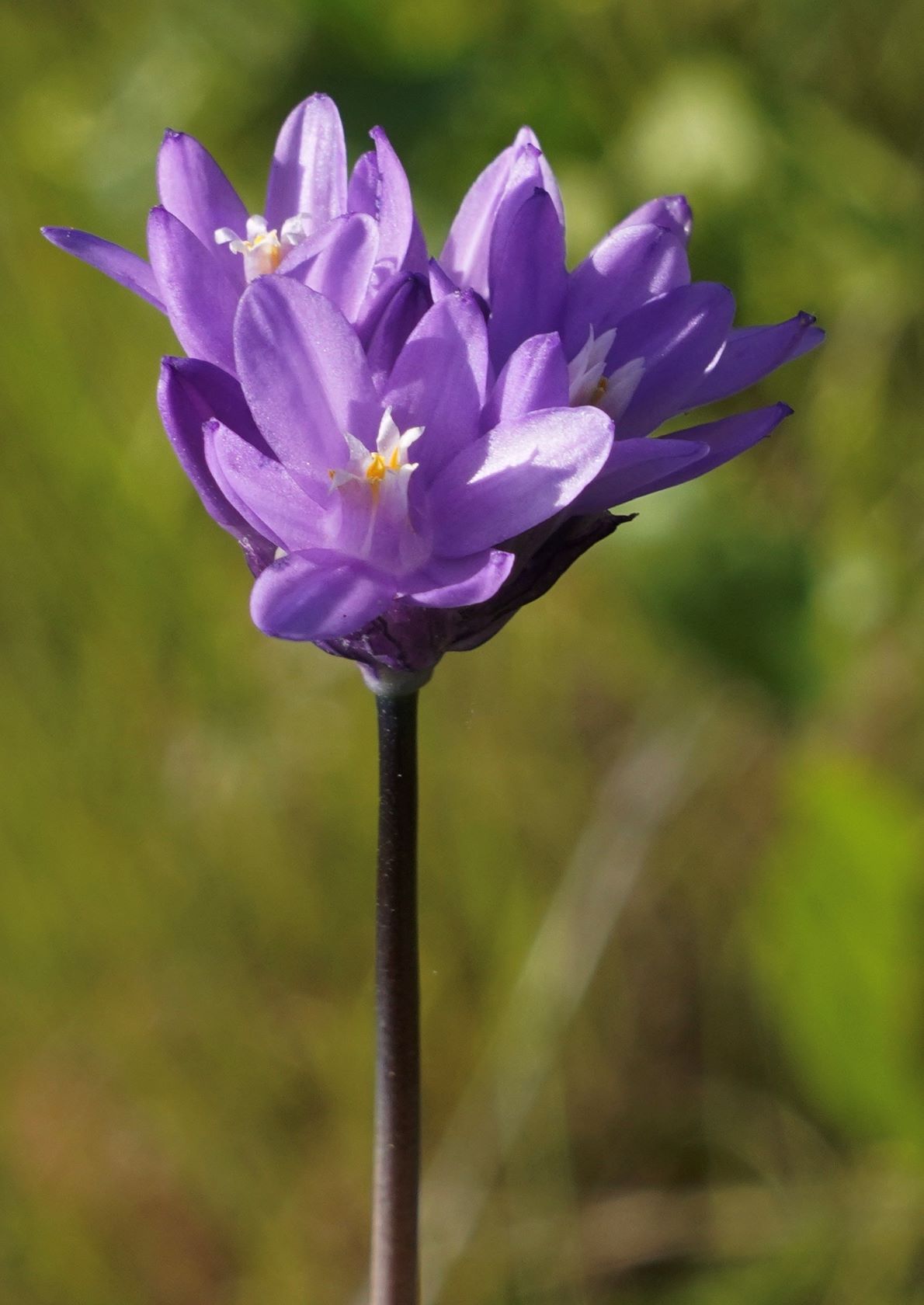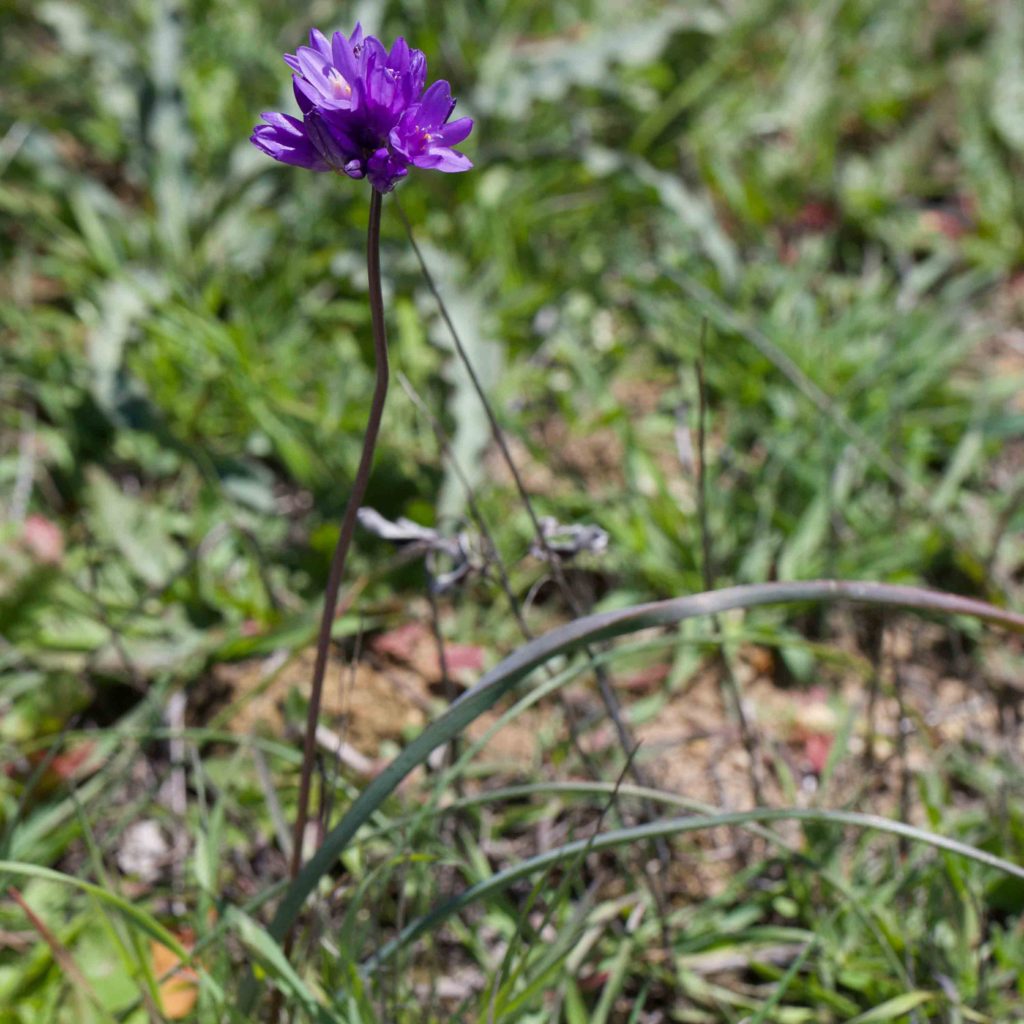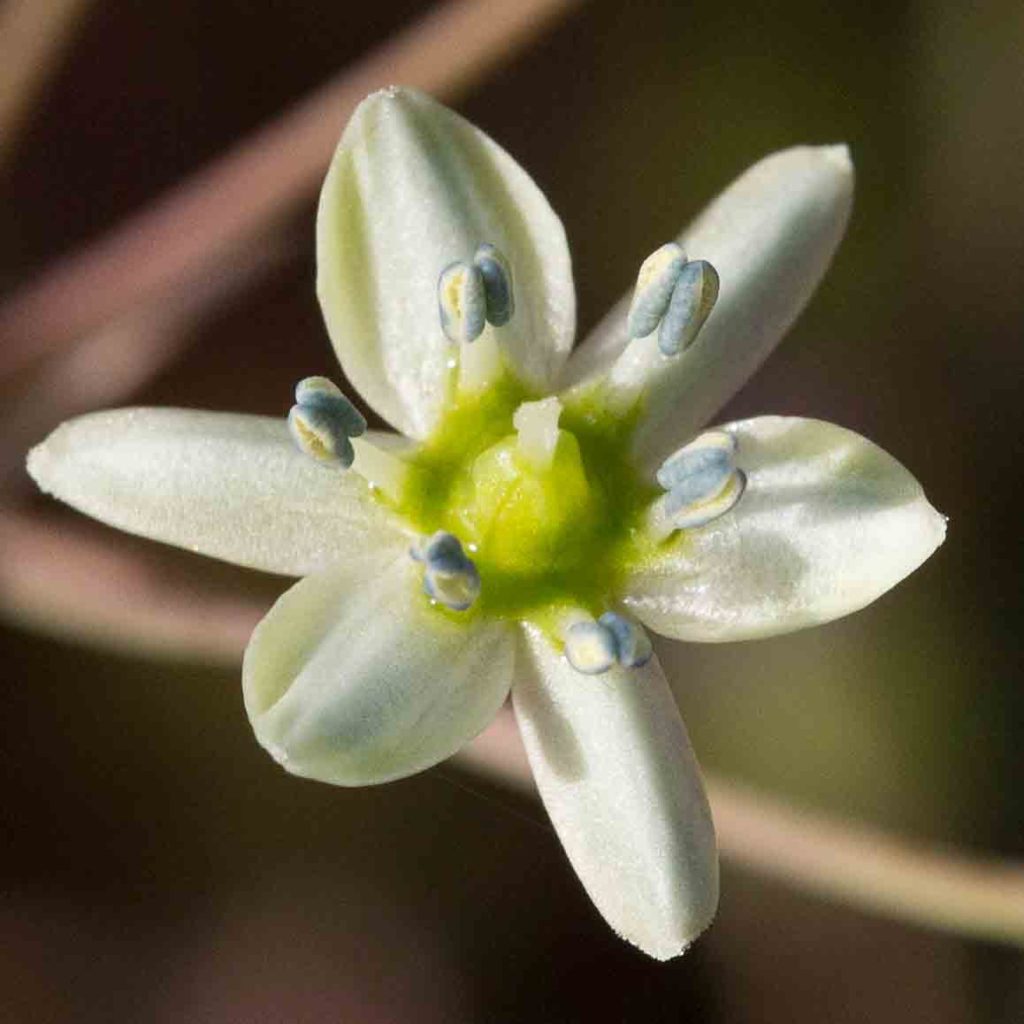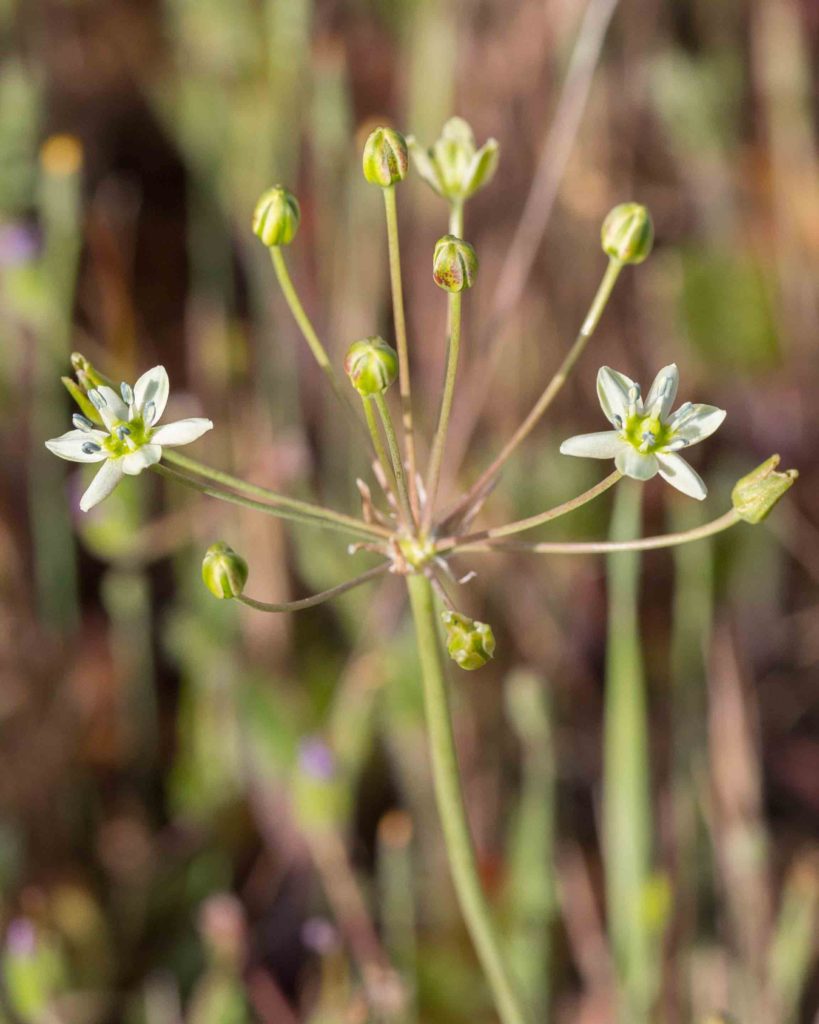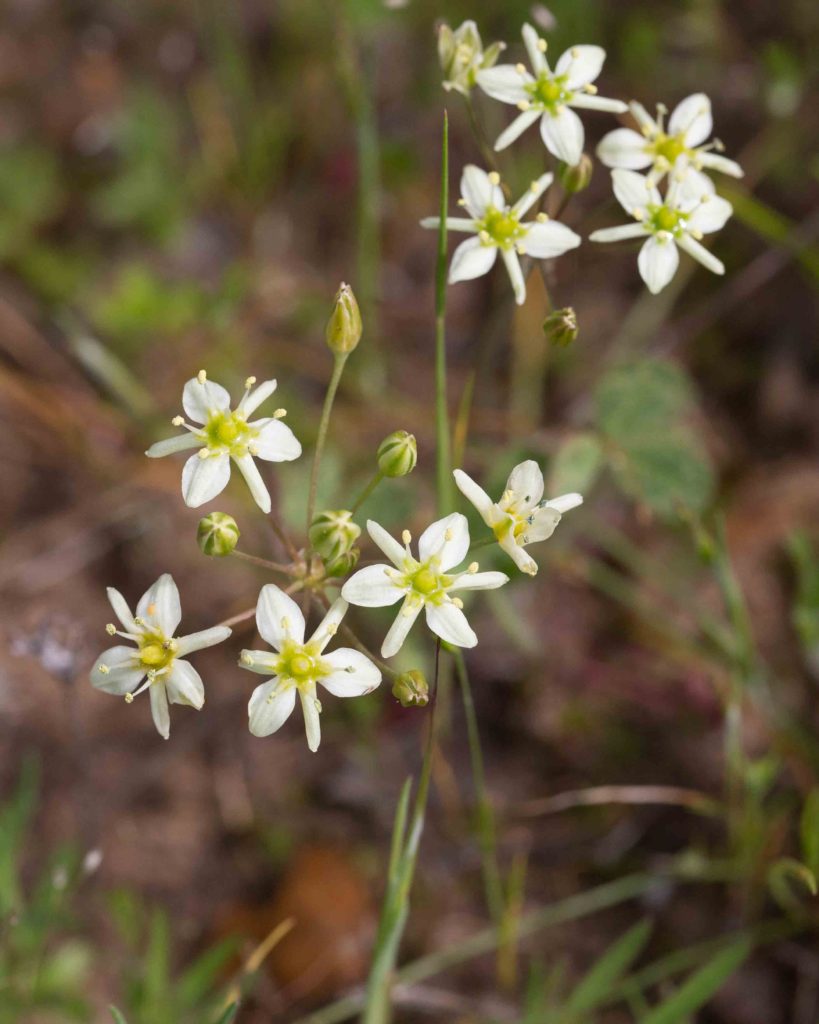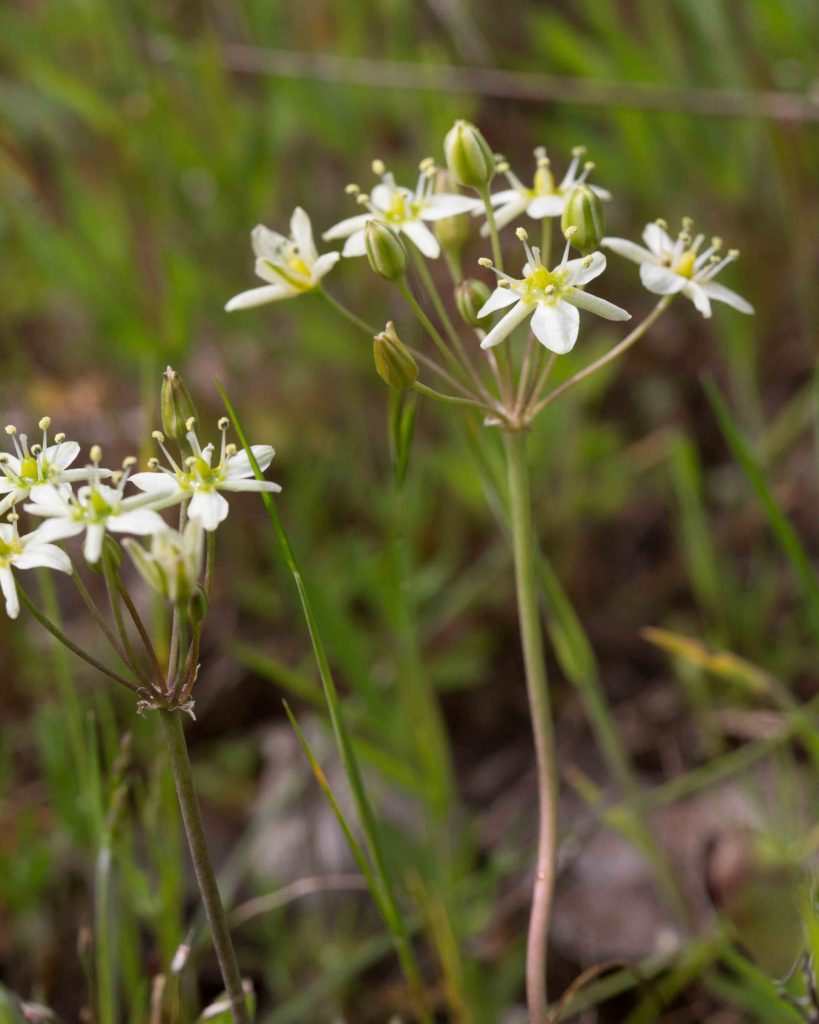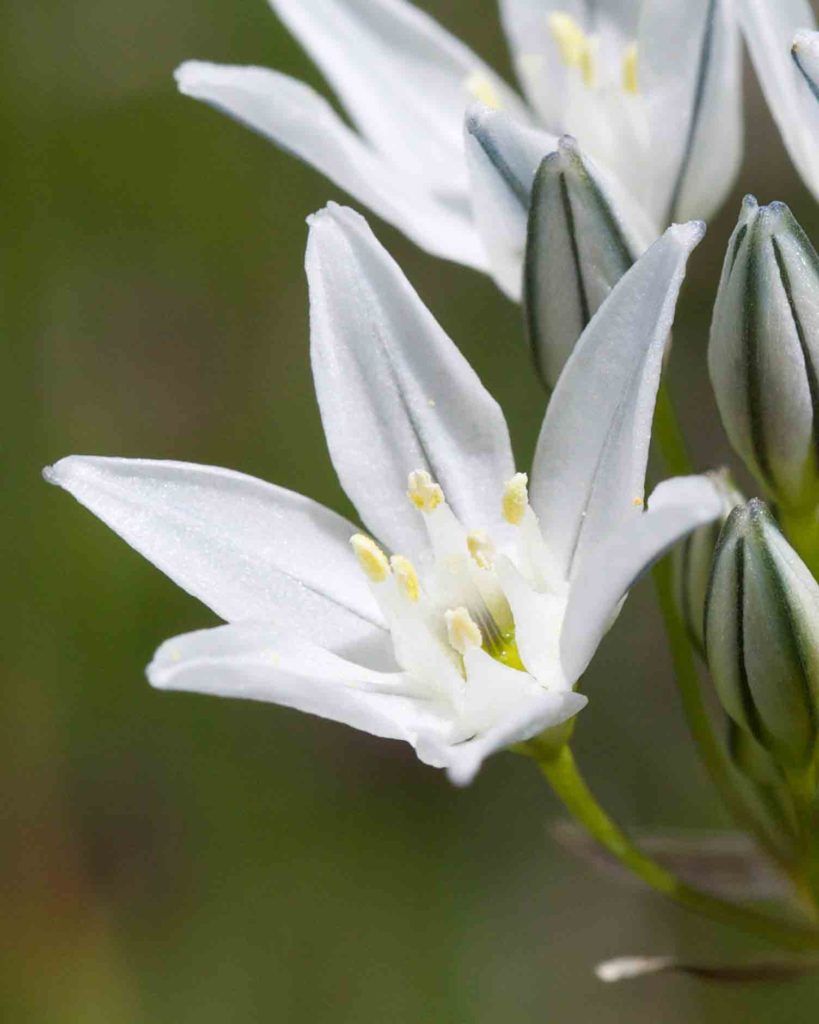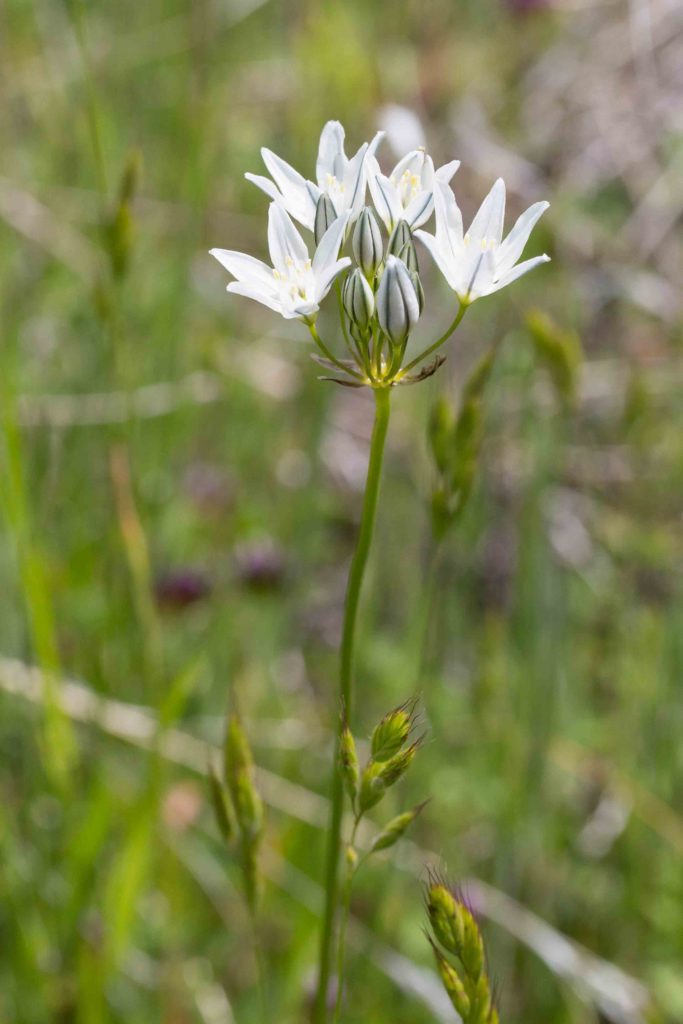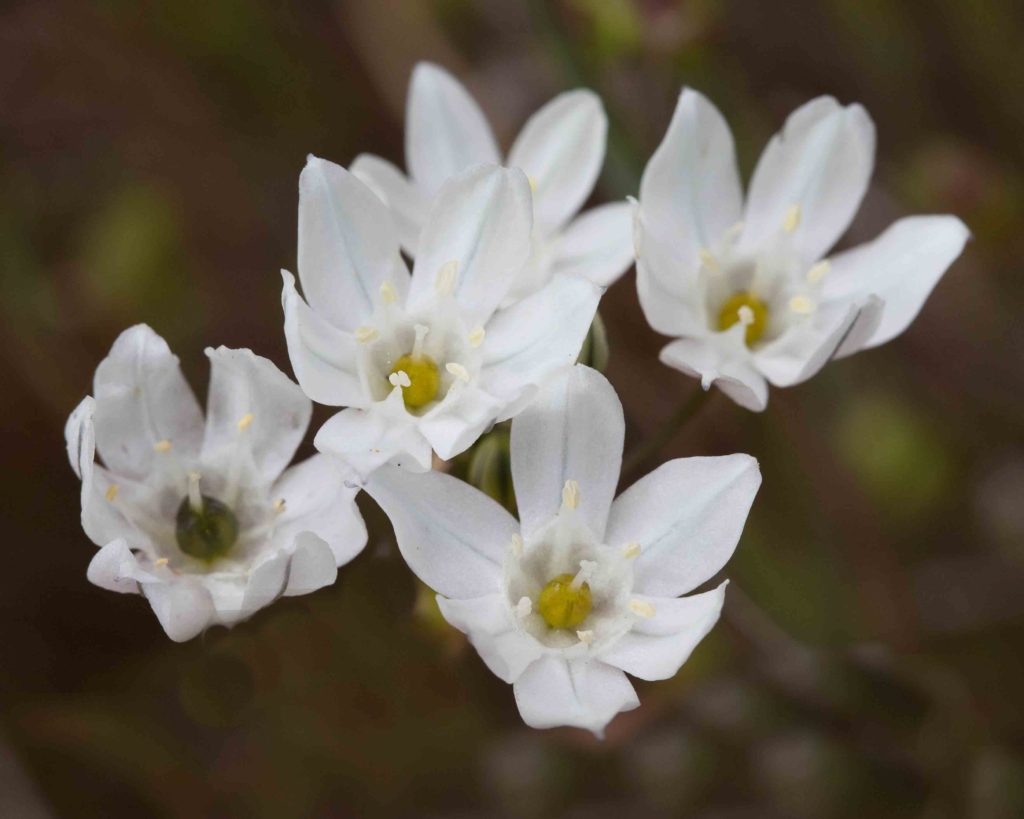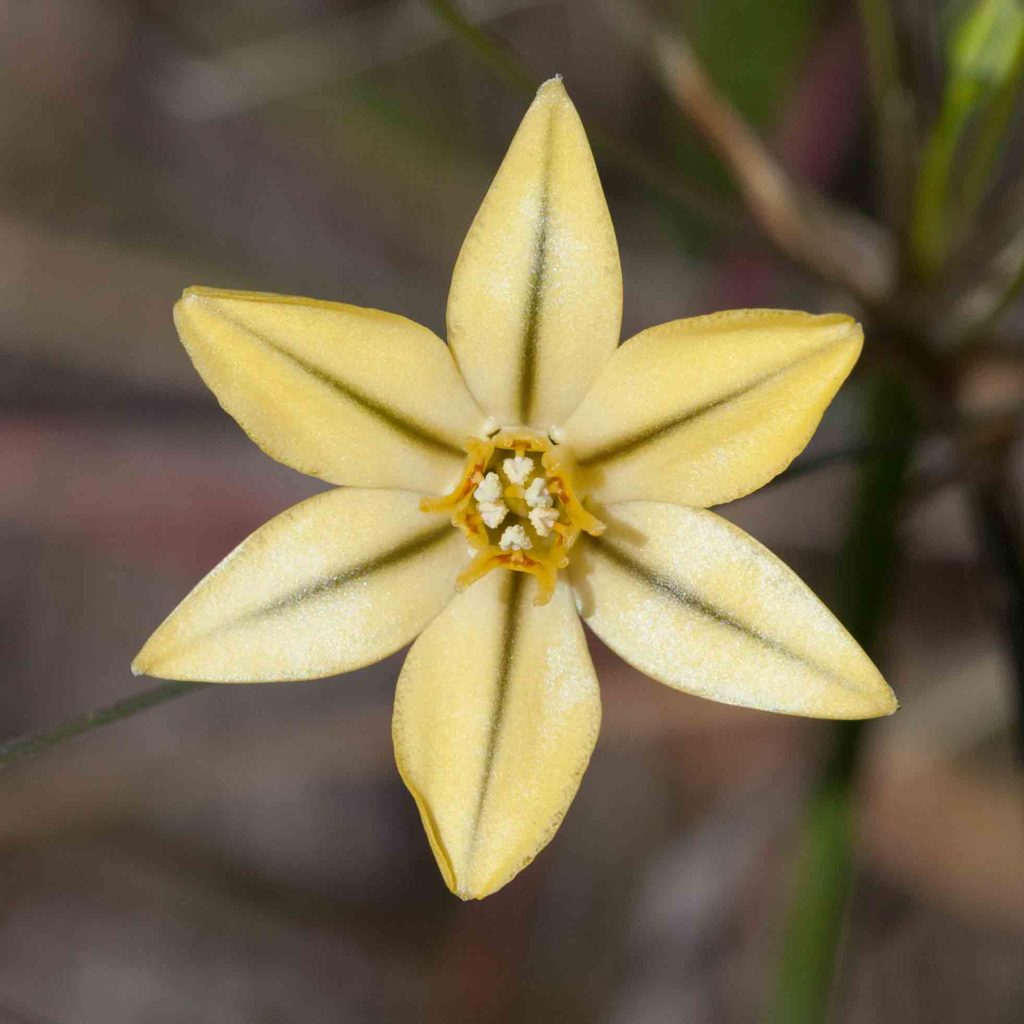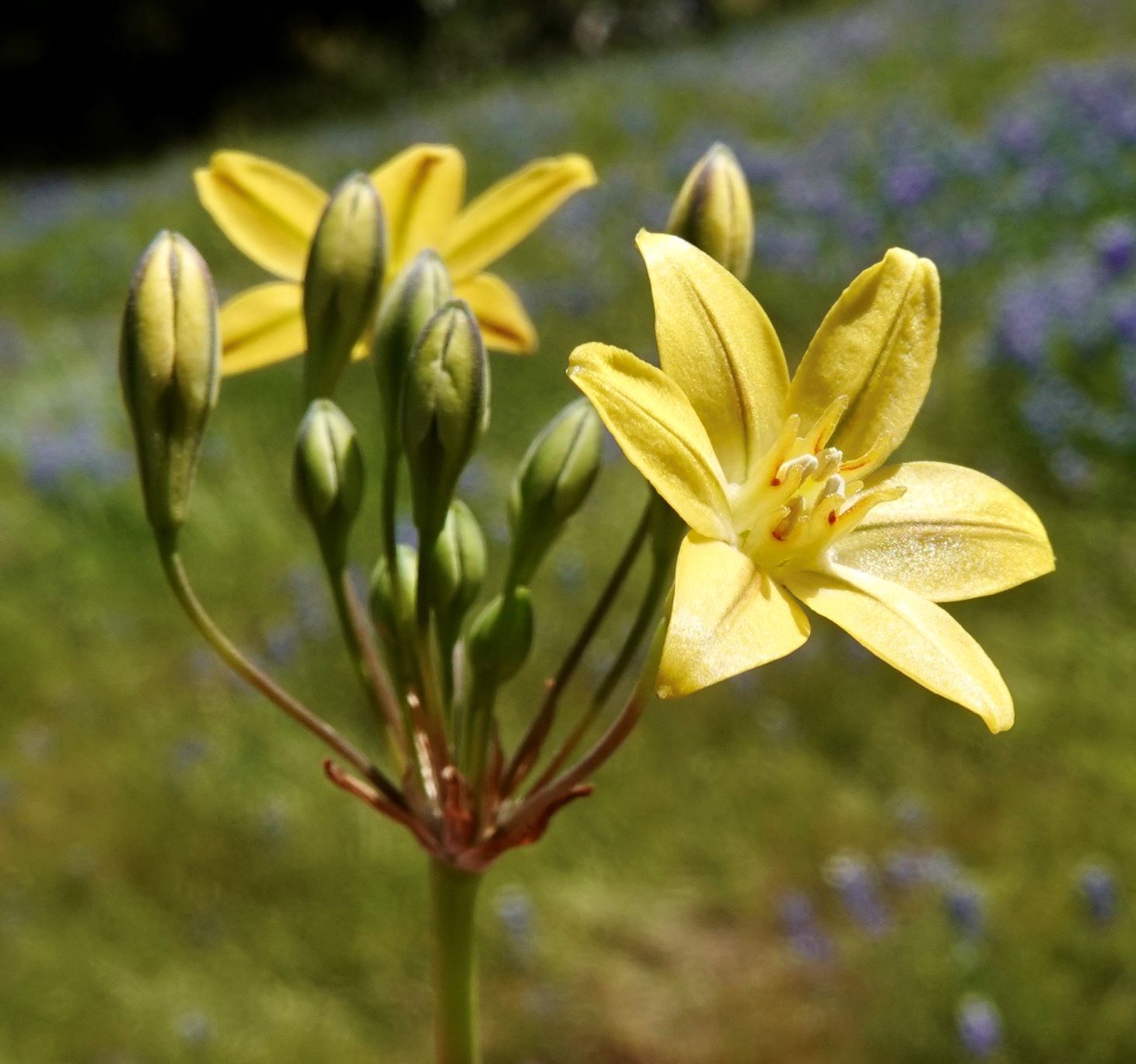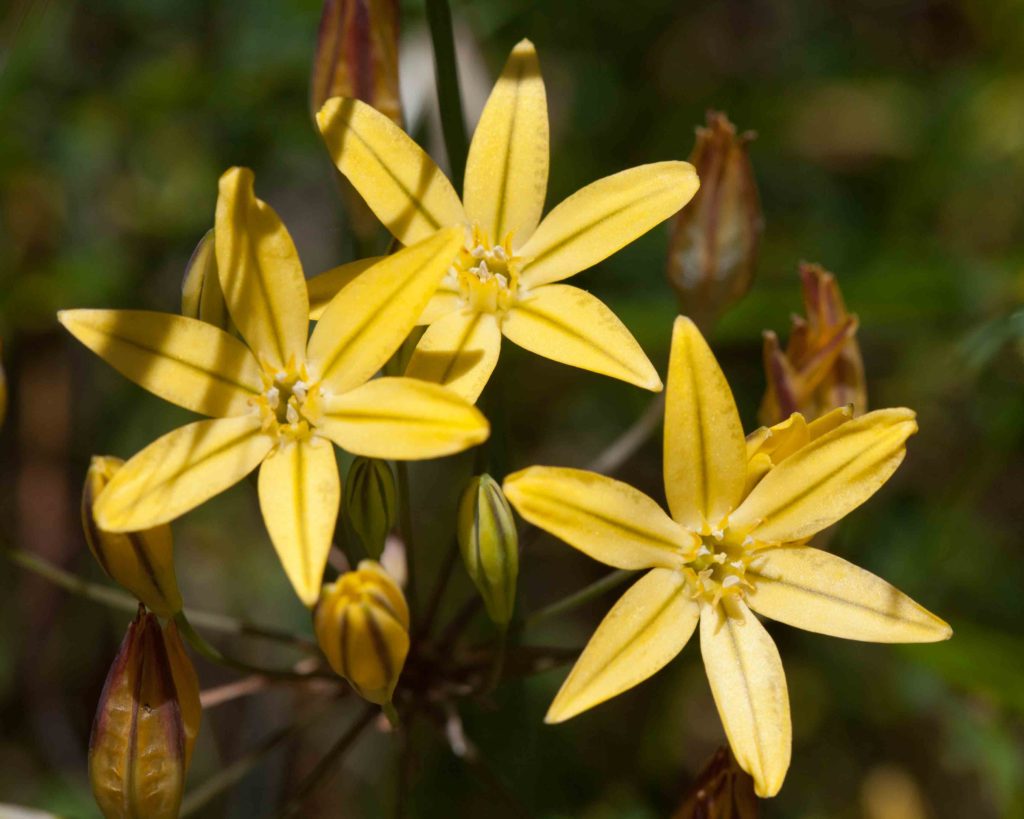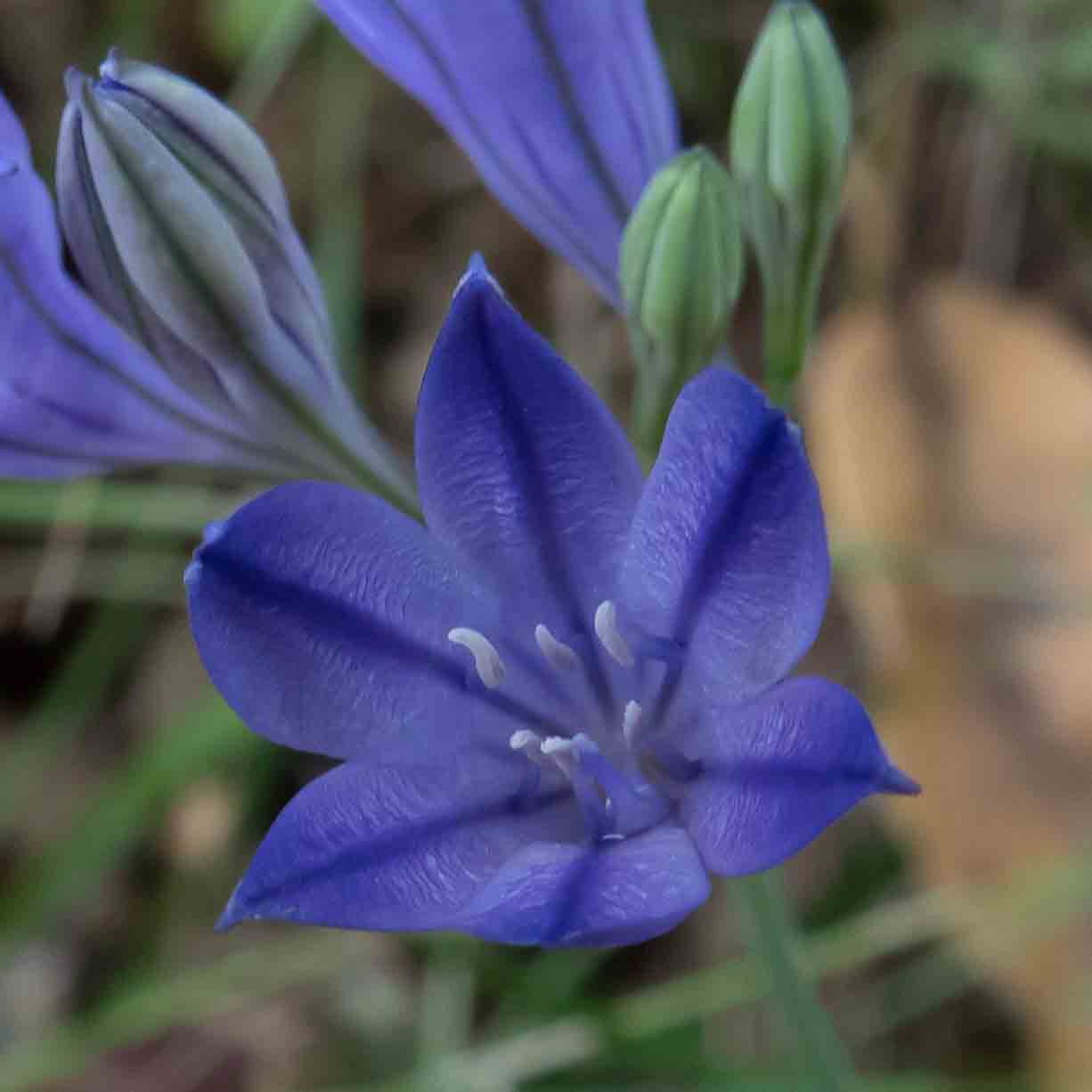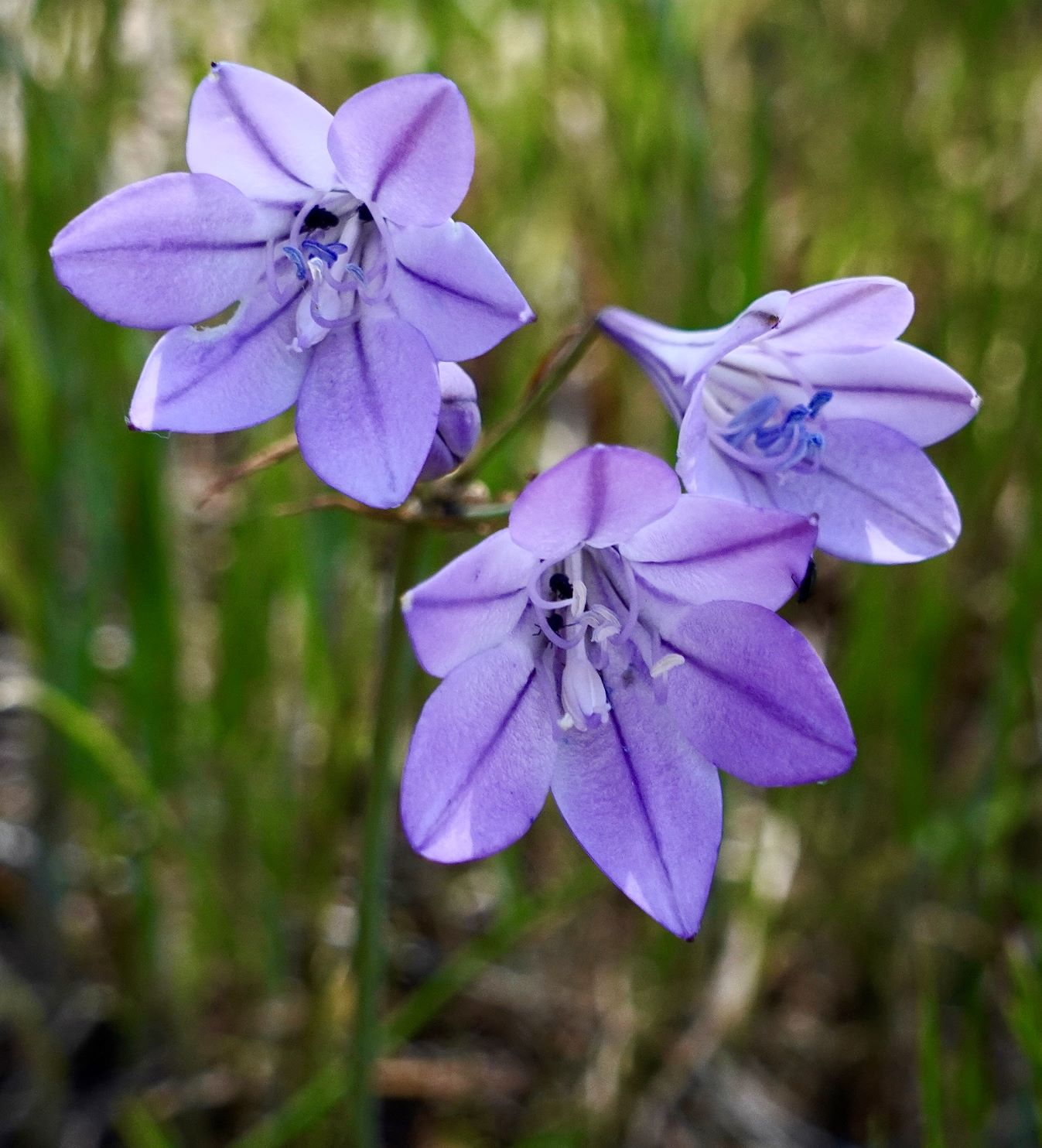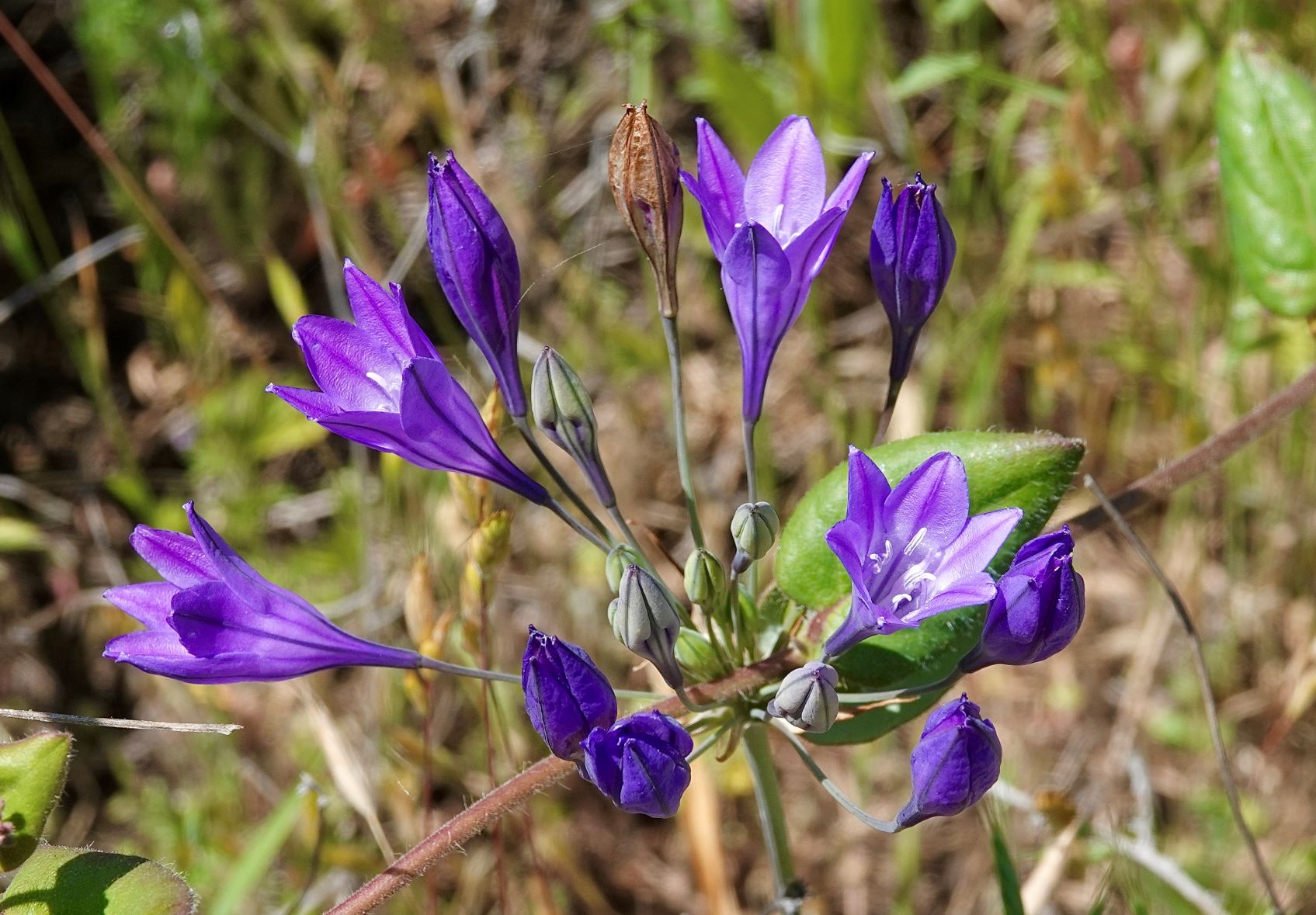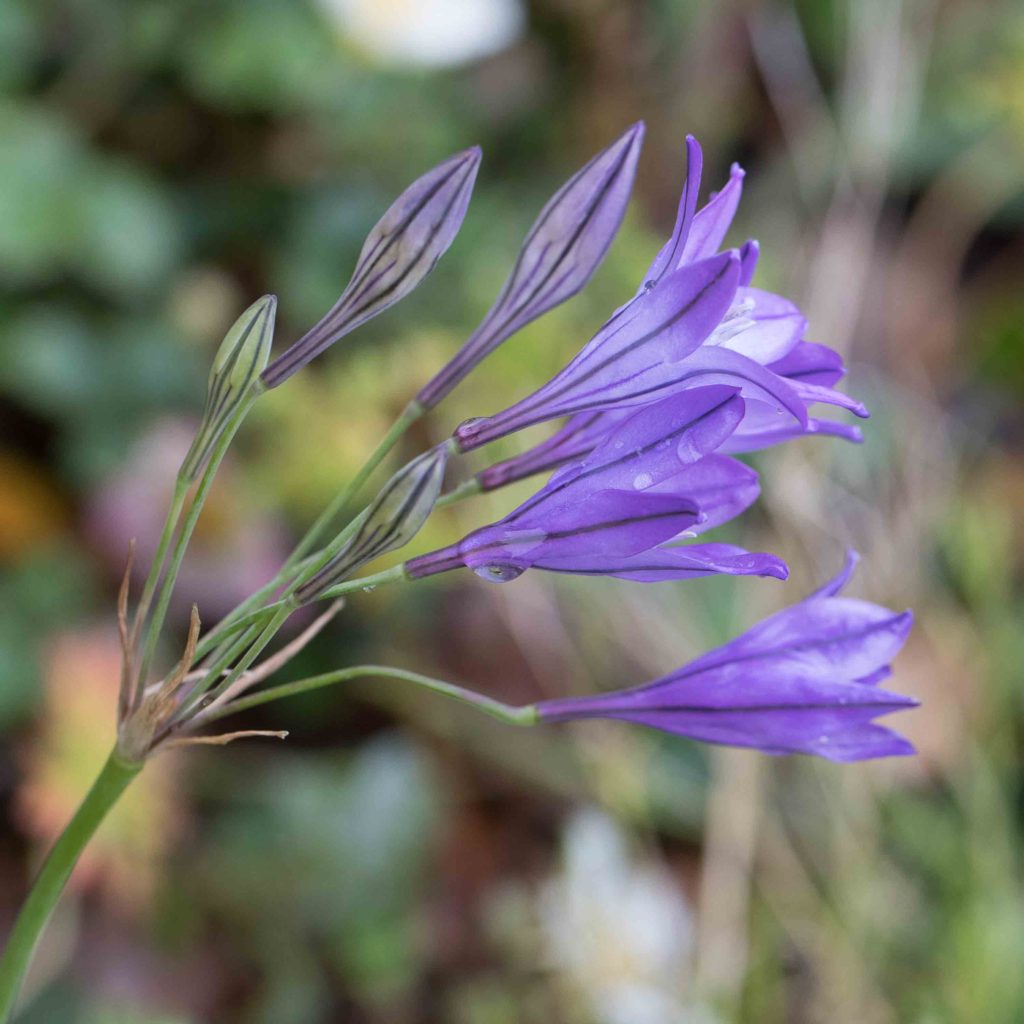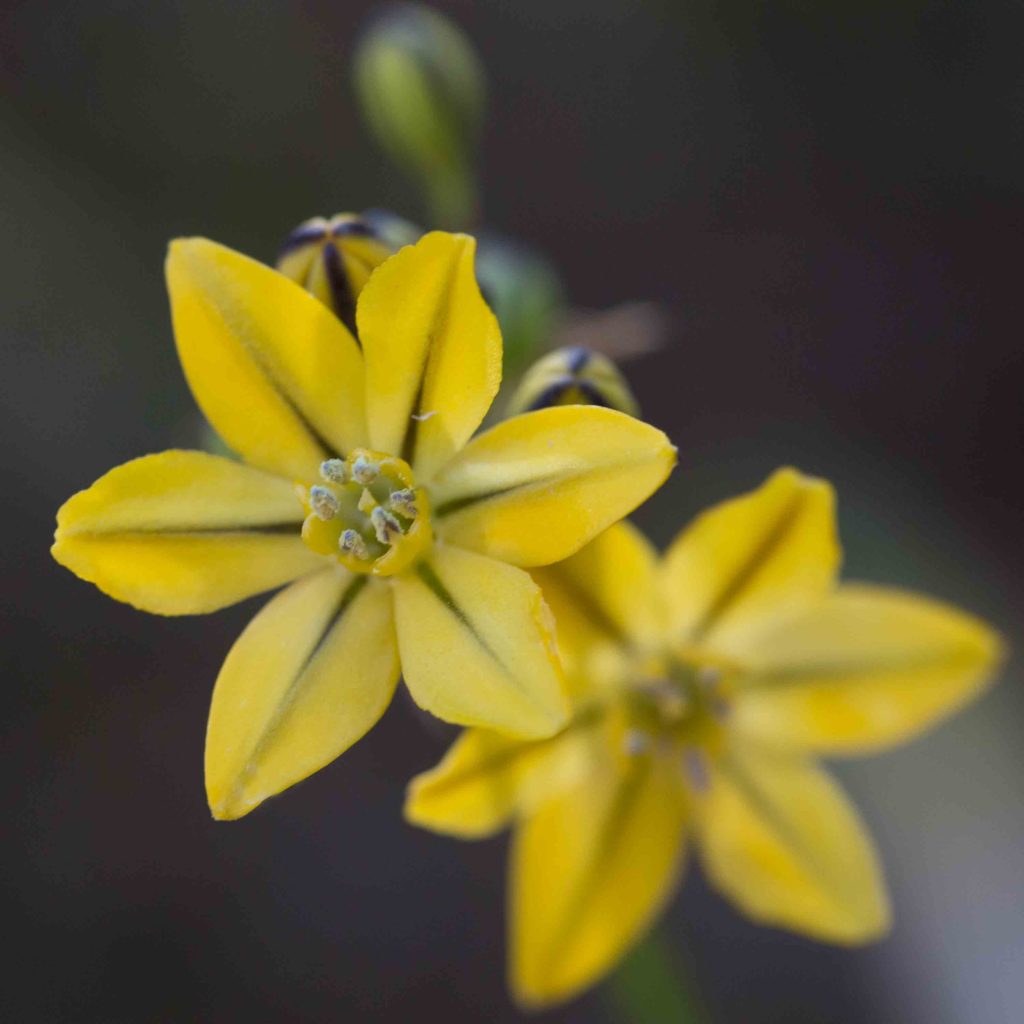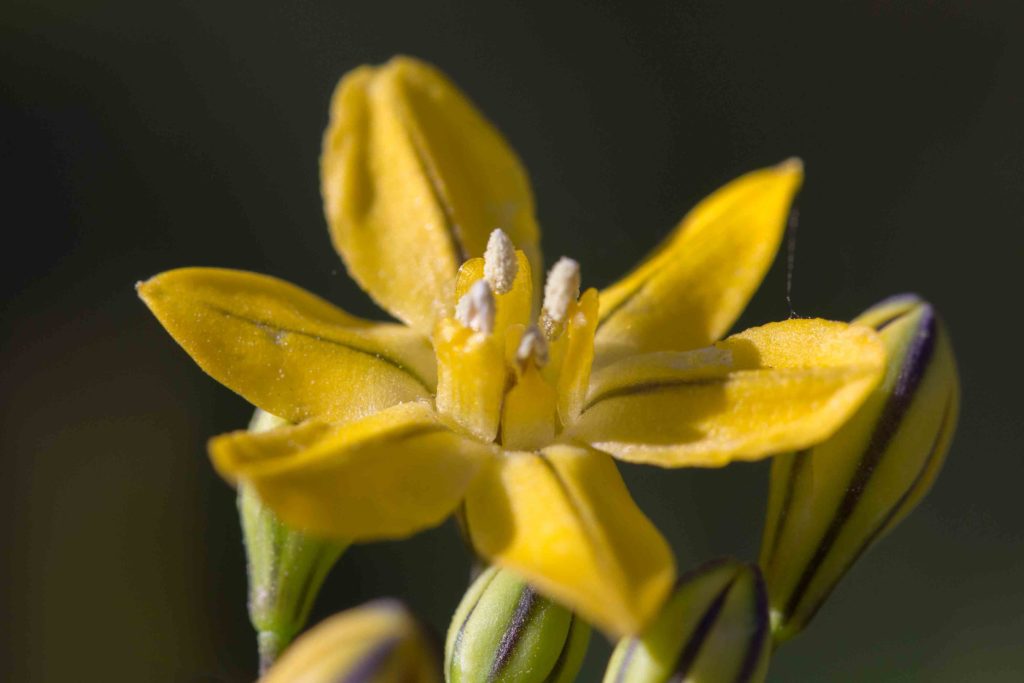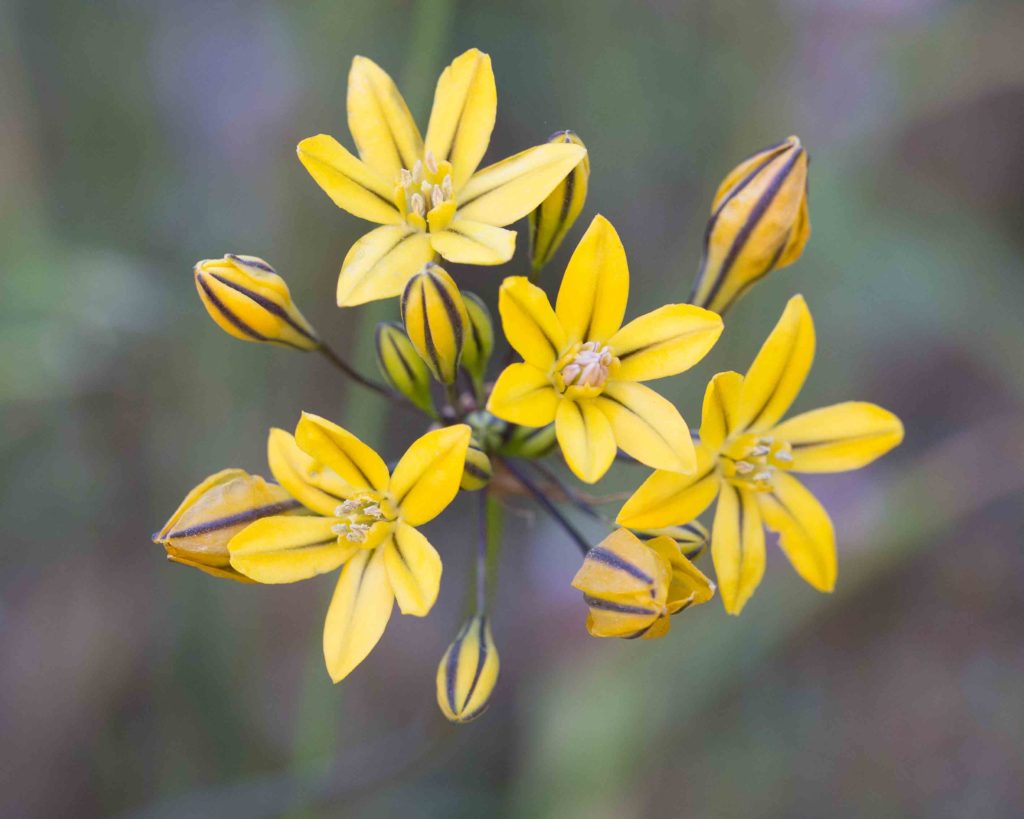Themidaceae: Brodiaea Family
Common Goldenstar – Bloomeria crocea var. aurea
Blooms:
Apr–June
Plant Height:
< 30 cm
Flower Size:
Medium
Origin:
Native
Habitat:
Dry flats & hillsides
Notes:
At first glance, this might be mistaken for Pretty Face (Triteleia ixioides, see below). But the narrow, strap-like perianth lobes are distinctly different. More important, the filament bases are expanded to form a nectar cup. This cup has shallow to awned cusps between the upper, thread-like parts of the filaments. The filaments are strongly exserted, and parallel to each other.
There are two varieties of this species, both called “Common Goldenstar”. In this variety, the nectar cup cusps are awn-like, 1–3 mm long. An uncommon plant, generally found in the southeastern part of the county.
Common Goldenstar – Bloomeria crocea var. crocea
Blooms:
Apr–June
Plant Height:
< 30 cm
Flower Size:
Medium
Origin:
Native
Habitat:
Dry flats & hillsides
Notes:
At first glance, this might be mistaken for Pretty Face (Triteleia ixioides, see below). But the narrow, strap-like perianth lobes are distinctly different. More important, the filament bases are expanded to form a nectar cup. This cup has shallow to awned cusps between the upper, thread-like parts of the filaments. The filaments are strongly exserted, and parallel to each other.
There are two varieties of this species, both called “Common Goldenstar”. This one is very similar to var. aurea, except that the nectar cup cusps are very shallow and not awn-like, < 1 mm long. An uncommon plant, generally found in the southeastern part of the county, but also on Cachagua Road.
Garland Brodiaea – Brodiaea coronaria
Blooms:
Apr–June
Plant Height:
5–25 cm
Flower Size:
Medium
Origin:
Native
Habitat:
Grassland and vernal pools
Notes:
This is similar to Mesa / Jolon Brodiaea (Brodiaea jolonensis, see below), although sometimes a little taller. It is distinguishable by its staminodes, the more or less erect, white, sterile stamens. The staminodes are barely inrolled on the margins, and parallel to or leaning slightly away from the true stamens. The whitish anthers are not notched, unlike both Mesa /Jolon and Dwarf Brodiaeas (Brodiaea jolonensis & terrestris).
This is also very similar to Harvest / Elegant Brodiaea (B. elegans subsp. elegans, see below). It is somewhat smaller, and there are subtle differences in the appearance of the staminodes. Although not common, it is far more widespread across Monterey County than the Harvest / Elegant Brodiaea, which is confined to the far north portion.
Harvest / Elegant Brodiaea – Brodiaea elegans subsp. elegans
Blooms:
Apr–August
Plant Height:
10–50 cm
Flower Size:
Medium
Origin:
Native
Habitat:
Heavy soils of open or wooded flats & foothills
Notes:
This is very similar to Garland Brodiaea (B. coronaria, see above). It is somewhat taller, and distinguishable by its staminodes. These white, more or less erect, sterile stamens are flat on the margins, and held away from the true stamens, not leaning towards them as with the Garland Brodiaea. The staminodes are also slightly smaller than the true stamens, unlike those of Garland Brodiaea which are slightly longer.
This is found only in the far north of the county, and is sometimes found growing near Ithuriel’s Spear (Triteleia laxa, see below). Any temptation to confuse these two outwardly similar flowers (see the third photo) should be resisted. The growth habit is different; Triteleias have a marked umbel-like inflorescence, while the Brodiaea inflorescence is more open, and the individual flowers of Triteleias have no staminodes, that are so clearly present in the Brodiaeas.
Mesa / Jolon Brodiaea – Brodiaea jolonensis
Blooms:
Apr–June
Plant Height:
5–15 cm
Flower Size:
Medium
Origin:
Native
Habitat:
Clay depressions on flats and gentle slopes
Notes:
This is similar in color to Dwarf Brodiaea (Brodiaea terrestris, see below), but taller. It can be distinguished by its staminodes. These are violet with square tops, slightly incurved on the sides, and leaning inwards towards the stamens. The anthers are whitish, with a V-shaped notch. Pale, almost white forms are occasionally found. As the alternate common name suggests, it is common in the Fort Hunter Liggett / Indians area, although it is also found in counties further south.
Dwarf Brodiaea – Brodiaea terrestris subsp. terrestris
Blooms:
Apr–July
Plant Height:
< 13 cm
Flower Size:
Medium
Origin:
Native
Habitat:
Grassland and disturbed areas
Notes:
As the common name suggests, this is a very low-growing plant. Its violet, bell-shaped flowers are similar to those of Mesa / Jolon and Garland Brodiaeas (Brodiaea jolonensis & coronaria, see above for both). But it can be distinguished by its growth habit, and also by its whitish anthers, which have a U-shaped notch. Also, its staminodes are white, noticeably incurved on the sides, and slightly reflexed at the tip. Photo #1 by CJH.
Blue Dicks – Dipterostemon capitatus subsp. capitatus (formerly Dichelostemma capitatum subsp. capitatum)
Blooms:
Mar–June
Plant Height:
5–70 cm
Flower Size:
Small cluster
Origin:
Native
Habitat:
Flats and hillsides
Notes:
This is a common plant, easily recognized by its dense heads of 6–15 blue to pink-purple flowers. Each flower is 6-lobed, and has a distinctive triangular crown in the center. This crown leans in towards the anthers, but is reflexed, and deeply notched at the tip. There are 2–3 slender leaves as long as or longer than the stems. Photos #1-2 by CJH.
Note: The scientific name has changed (The Jepson Manual Revision 7, 2019)
Common Muilla – Muilla maritima
Blooms:
Mar–June
Plant Height:
10–50 cm
Flower Size:
Medium
Origin:
Native
Habitat:
Subalkaline flats and granite or serpentine slopes
Notes:
This has an erect stem with 3–10 linear, basal leaves, 10–70 cm long. The flowers are in umbels of 6–15 on pedicels < 5 cm long. Each flower has 6 perianth lobes, < 6 mm long, greenish-white in color with brownish midribs. There are 6 erect stamens with blue, green or purplish anthers.
"Muilla" is "Allium" (the scientific name for the onion genus which this plant resembles) spelled backwards.
White Brodiaea / Wild Hyacinth – Triteleia hyacinthina
Blooms:
May–July
Plant Height:
10–40 cm
Flower Size:
Medium
Origin:
Native
Habitat:
Low moist places in meadows and along streams
Notes:
This is like other Brodiaeas in its general appearance, but its flowers are pure white, with green midveins. The perianth lobes are not narrowed at the base. The stamens are of equal length, and attached at the same level (something that it not true of all members of this family). Leaves are 10–40 cm long, and up to 22 mm wide.
Pretty Face / Golden Brodiaea – Triteleia ixioides subsp. ixioides
Blooms:
Mar–Aug
Plant Height:
10–40 cm
Flower Size:
Medium
Origin:
Native
Habitat:
Foothill woodland and closed-cone conifer forests
Notes:
This beautiful flower is common late spring to mid-summer. It has a single stem with an umbel of golden star-shaped flowers, each limb with a dark central vein. The 6 flat stamens alternate between long and short, the long ones each having a pair of horn-like appendages. Photos #2 and 4 by CJH.
Common Triteleia / Ithuriel's Spear – Triteleia laxa
Blooms:
Apr–June
Plant Height:
10–70 cm
Flower Size:
Medium
Origin:
Native
Habitat:
Woodland, grassland on clay soil
Notes:
This has a tall stem, with an umbel of blue-purple or white flowers. The flower tube is tapered at the base, and the stamens are of equal length. This is the only bluish-purple Triteleia to be found in the county. It is more common north of Monterey county than within it. Photos #2-3 by CJH.
Dark-mouthed Triteleia – Triteleia lugens
Blooms:
Mar–Aug
Plant Height:
10–40 cm
Flower Size:
Medium
Origin:
Native
Rare or endangerd?
Yes - 4.3
Habitat:
Chaparral & woodland margins, streambanks
Notes:
This is an uncommon flower, found only near the Monterey / San Benito County line. With its 6 yellow limbs and their prominent dark veins, it could be mistaken for Pretty Face (Triteleia ixioides, see above). However, the flowers are slightly smaller, and deeper yellow. In addition, the pedicels are shorter (10–25 mm vs 10–70 mm), so the inflorescence has a more compact appearance. Also, the tips of the longer stamens, which are rounded and knobby, lack the horn-like appendages found in Pretty Face.


